Examples
NV center - DC Magnetometry
- class Magnetometry(particle_filter: ParticleFilter, phys_model: NVCenter, control_strategy: Callable, simpars: SimulationParameters, cov_weight_matrix=None, eta_flag: bool = False, extraction_flag: bool = False, cov_flag: bool = False)
Bases:
StatelessMetrologySimulates the estimation of a magnetic field with a mean square error loss. This class is suitable for a neural network agent, for a static strategy, and for other simple controls known in the literature, like the
strategy and the particle guess heuristic (PGH). It works both for static and for oscillating magnetic fields.
Constructor of the
Magnetometryclass.Parameters
- particle_filter:
ParticleFilter Particle filter responsible for the update of the Bayesian posterior on the parameters and on the state of the probe. It contains the methods for applying the Bayes rule and computing Bayesian estimators from the posterior.
- phys_model:
NVCenter Abstract description of the parameters encoding and of the measurement on the NV center.
- control_strategy: Callable
Callable object (normally a function or a lambda function) that computes the values of the controls for the next measurement from the Tensor input_strategy. This class expects a callable with the following header
controls = control_strategy(input_strategy)It is typically a wrapper for the neural network or a vector of static controls.
- simpars:
SimulationParameters Contains the flags and parameters that regulate the stopping condition of the measurement loop and modify the loss function used in the training.
- cov_weight_matrix: List, optional
Weight matrix that determines the relative contribution to the total error of the parameters in phys_model.params. It is list of float representing a positive semidefinite matrix. If this parameter is not passed then the default weight matrix is the identity, i.e.
.
- eta_flag: bool = False
This flag controls the addition of a normalization factor to the MSE loss.
If eta_flag is True, the MSE loss is divided by the normalization factor
(56)
where
are the bounds of the i-th parameter in phys_model.params and
are the diagonal entries of cov_weight_matrix.
is the total elapsed evolution time, which can be different for each estimation in the batch.
Achtung! This flag should be used only if the resource is the total estimation time.
- extraction_flag: bool = False
If extraction_flag=True a couple of particles are sampled from the posterior and added to the input_strategy Tensor. This is useful to simulate the PGH control for the evolution time, according to which the k-th control should be
(57)
with
, where
and
are respectively the first and the second particle extracted from the ensemble and
is the cartesian norm.
- cov_flag: bool = False
If cov_flag=True a flattened version of the covariance matrix of the particle filter ensemble is added to the input_strategy Tensor. This is useful to simulate the
control strategy and its variant that accounts for a finite transversal relaxation time. They prescribe respectively for the k-th control
(58)
and
(59)
being
the covariance matrix of the posterior computed with the
compute_covariance()method.
- generate_input(weights: Tensor, particles: Tensor, meas_step: Tensor, used_resources: Tensor, rangen: Generator)
Generates the input_strategy Tensor of the
generate_input()method. The returned Tensor is influenced by the parameters extract_flag and cov_flag of the constructor.
- loss_function(weights: Tensor, particles: Tensor, true_values: Tensor, used_resources: Tensor, meas_step: Tensor)
Mean square error on the parameters, as computed in
loss_function(). The behavior of this method is influence by the flag eta_flag passed to the constructor of the class.
- particle_filter:
- class NVCenter(batchsize: int, params: List[Parameter], prec: Literal['float64', 'float32'] = 'float64', res: Literal['meas', 'time'] = 'meas', control_phase: bool = False)
Bases:
StatelessPhysicalModelModel for the negatively charged NV center in diamond used for various quantum metrological task. A single measurement on the NV center consists in multiple Ramsey sequencies of the same controllable duration applied to the NV center, followed by photon counting of the photoluminescent photon and a majority voting to decide the binary outcome. The NV center is reinitialized after each photon counting. During the free evolution in the Ramsey sequence the NV center precesses freely in the external magnetic field, thereby encoding its value in its state. The two possible controls we have on the system are the duration of the free evolution
and the phase
applied before the photon counting. The resource of the estimation task can be either the total number of measurements or the total evolution time.
Achtung! The
model()method must still be implemented in this class. It should describe the probability of gettingin the measurement after the majority voting from the collected photons.
Constructor of the
NVCenterclass.Parameters
- batchsize: int
Batchsize of the simulation, i.e. number of estimations executed simultaneously.
- params: List[
Parameter] List of unknown parameters to estimate in the NV center experiment, with their respective bounds.
- prec{“float64”, “float32”}
Precision of the floating point operations in the simulation.
- res: {“meas”, “time”}
Resource type for the present metrological task, can be either the total evolution time, i.e. time, or the total number of measurements on the NV center, i.e. meas.
- control_phase: bool = False
If this flag is True, beside the free evolution time, also the phase applied before the photon counting is controlled by the agent.
- count_resources(resources: Tensor, outcomes: Tensor, controls: Tensor, true_values: Tensor, meas_step: Tensor)
The resources can be either the total number of measurements, or the total evolution time, according to the attribute res of the
NVCenterclass.
- perform_measurement(controls: Tensor, parameters: Tensor, meas_step: Tensor, rangen: Generator) Tuple[Tensor, Tensor]
Measurement on the NV center.
The NV center is measured after having evolved freely in the magnetic field for a time specified by the parameter control. The possible outcomess are
and
, selected stochastically according to the probabilities
, where
is the evolution time (the control) and
the parameters to estimate. This method returns the observed outcomes and their log-likelihood.
Achtung! The
model()method must return the probability
- class NVCenterDCMagnetometry(batchsize: int, params: List[Parameter], prec: Literal['float64', 'float32'] = 'float64', res: Literal['meas', 'time'] = 'meas', invT2: Optional[float] = None)
Bases:
NVCenterModel describing the estimation of a static magnetic field with an NV center used as magnetometer. The spin-spin relaxation time
can be either known, or be a parameter to estimate. The estimation will be formulated in terms of the precession frequency
of the NV center, which is proportional to the magnetic field
.
This physical model and the application of Reinforcement Learning to the estimation of a static magnetic fields have been also studied in the seminal work of Fiderer, Schuff and Braun 1.
Constructor of the
NVCenterDCMagnetometryclass.Parameters
- batchsize: int
Batchsize of the simulation, i.e. number of estimations executed simultaneously.
- params: List[
Parameter] List of unknown parameters to estimate in the NV center experiment, with their respective bounds.
- prec{“float64”, “float32”}
Precision of the floating point operations in the simulation.
- res: {“meas”, “time”}
Resource type for the present metrological task, can be either the total evolution time, i.e. time, or the total number of measurements on the NV center, i.e. meas.
- invT2: float, optional
If this parameter is specified only the precession frequency
is considered as an unknown parameter, while the inverse of the transverse relaxation time
is fixed to the value invT2. In this case the list params must contain a single parameter, i.e. omega. If no invT2 is specified, it is assumed that it is an unknown parameter that will be estimated along the frequency in the Bayesian procedure. In this case params must contain two objects, the second of them should be the inverse of the transversal relaxation time.
- model(outcomes: Tensor, controls: Tensor, parameters: Tensor, meas_step: Tensor, num_systems: int = 1) Tensor
Model for the outcome of a measurement on a NV center subject to free precession in a static magnetic field. The probability of getting the outcome
is
(60)
The evolution time
is controlled by the trainable agent, and
is the unknown precession frequency, which is proportional to the magnetic field. The parameter
may or may not be an unknown in the estimation, according to the value of the attribute invT2 of the
NVCenterDCMagnetometryclass.
- main()
Runs the same simulations done by Fiderer, Schuff and Braun 1.
The performances of the optimized neural network and static strategies are reported in the following plot, together with other strategies commonly used in the literature. The resources can be the number of measurements or the total evolution time.
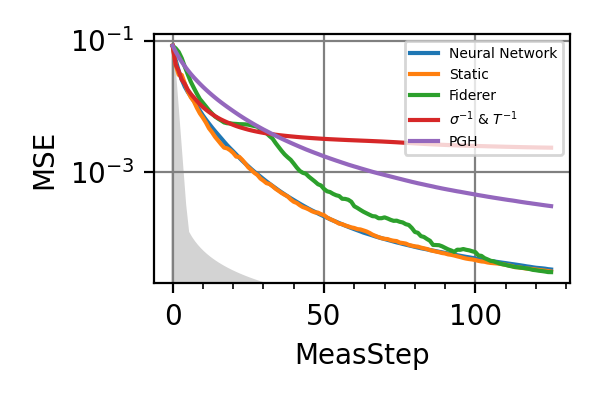
Fig. 1 invT2=0.01, Meas=128
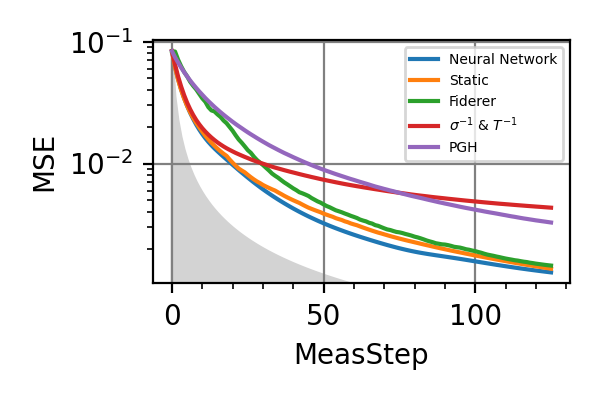
Fig. 2 invT2=0.1, Meas=128
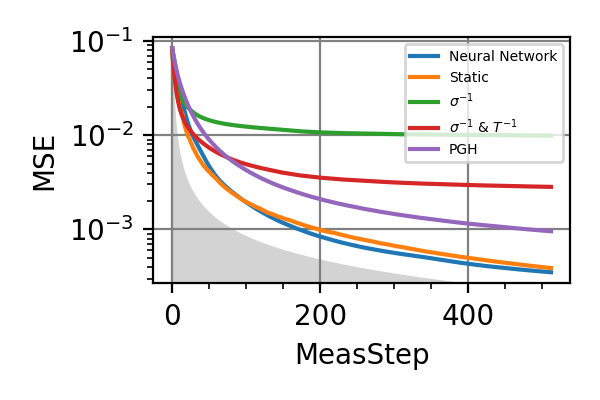
Fig. 3 invT2 in (0.09, 0.11), Meas=512
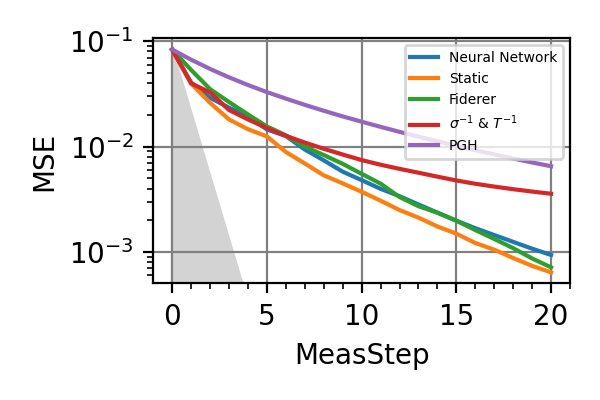
Fig. 4 invT2=0, Meas=24
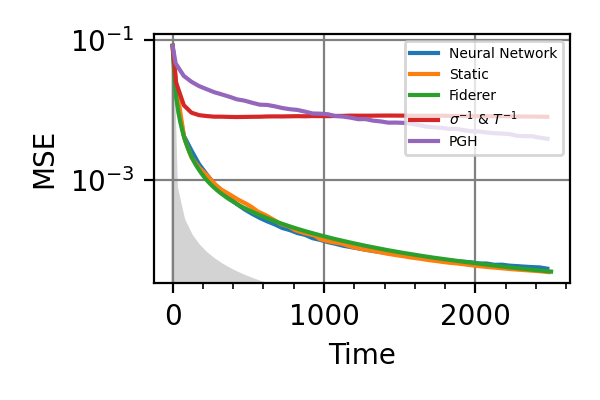
Fig. 5 invT2=0.01, Time=2560
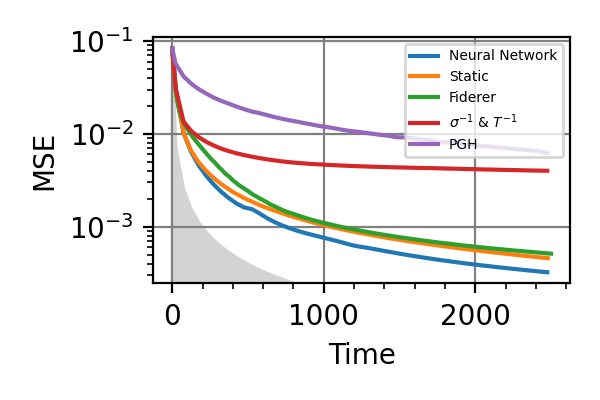
Fig. 6 invT2=0.1, Time=2560
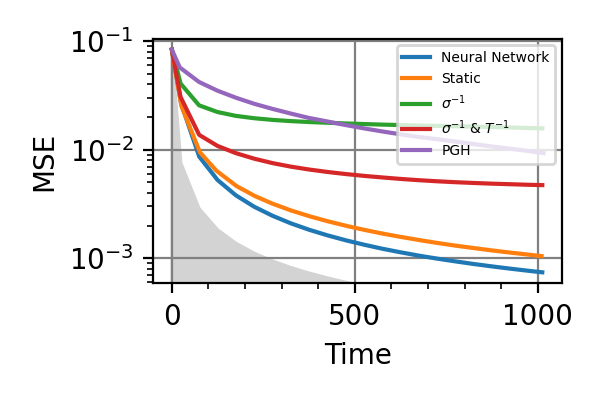
Fig. 7 invT2 in (0.09, 0.11), Time=1024
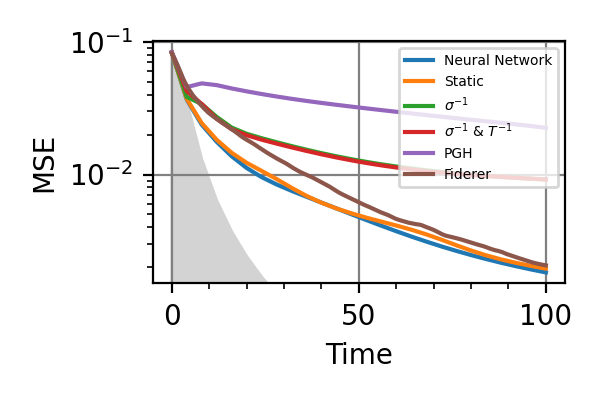
Fig. 8 invT2=0, Time=128
For the plot referring to the estimation of omega only the green line is the best performance found in the literature so far, obtained in 1 with model-free RL. In the plot corresponding to the simultaneous estimation of both the frequency and the decoherence time we din’t compare our results with 1 and the green line in simply the
.
The shaded grey areas in the above plot indicate the Bayesian Cramér-Rao bound, which is the the ultimate precision bound computed from the Fisher information.
From the above plots we can conclude that the adaptive strategy offers no advantage with respect to the optimal static strategy for those experiments limited in the number of measurements and for all those with a sufficiently high coherence time. For
we see some small advantage of the adaptive strategy in the time limited experiments. This observation is in accordance with the analysis based only on the Fisher information. For
the Fisher information of a single measurement is
and is independent on
. For
the Fisher information manifests a dependence on
, which could indicate the possibility of an adaptive strategy being useful, which is confirmed in these simulations.
Notes
The results of the simulations with invT2 in (0.09, 0.11) are very similar to that with invT2=0.1 because of the relatively narrow prior on invT2.
For an NV center used as a magnetometer the actual decoherence model is given by
instead of
Achtung! The performances of the time limited estimations with the
and the PGH strategies are not in accordance with the results of Fiderer, Schuff and Braun 1. Also the simulations with invT2 in (0.09, 0.11) do not agree with the results reported in this paper.
Normally in the applications the meaningful resource is the total time required for the estimation. This doesn’t coincide however with the total evolution time that we considered, because the initialization of the NV center, the read-out the and the data processing all take time. This overhead time is proportional to the number of measurements, so that in a real experiment we expect the actual resource to be a combination of the evolution time and the number of measurements.
In a future work the role of the higher moments of the posterior distribution in the determination of the controls should be explored. In particular it should be understood if with
(61)
more advantage from the adaptivity could be extracted.
In room-temperature magnetometry it is impossible to do single-shot readout of the NV center state (SSR). We should train the control strategy to work with non-SSR, as done by Zohar et al 2
All the trainings of this module have been done on a GPU NVIDIA Tesla V100-SXM2-32GB, each requiring
hours.
- 2
I Zohar et al, Quantum Sci. Technol. 8 035017 (2023).
- parse_args()
Arguments
- scratch_dir: str
Directory in which the intermediate models should be saved alongside the loss history.
- trained_models_dir: str = “./nv_center_dc/trained_models”
Directory in which the finalized trained model should be saved.
- data_dir: str = “./nv_center_dc/data”
Directory containing the csv files produced by the
performance_evaluation()and thestore_input_control()functions.- prec: str = “float32”
Floating point precision of the whole simulation.
- n: int = 64
Number of neurons per layer in the neural network.
- num_particles: int = 480
Number of particles in the ensemble representing the posterior.
- iterations: int = 32768
Number of training steps.
- scatter_points: int = 32
Number of points in the Resources/Precision csv produced by
performance_evaluation().
- static_field_estimation(args, batchsize: int, max_res: float, learning_rate: float = 0.01, gradient_accumulation: int = 1, cumulative_loss: bool = False, log_loss: bool = False, res: Literal['meas', 'time'] = 'meas', invT2: Optional[float] = None, invT2_bound: Optional[Tuple] = None, cov_weight_matrix: Optional[List] = None, omega_bounds: Tuple[float, float] = (0.0, 1.0))
Simulates the Bayesian estimation of a static magnetic field with an NV center, for a neural network controlling the evolution time, a static strategy, two variations of the
strategy, and the particle guess heuristic (PGH).
The measurement loop is showed in the following picture.
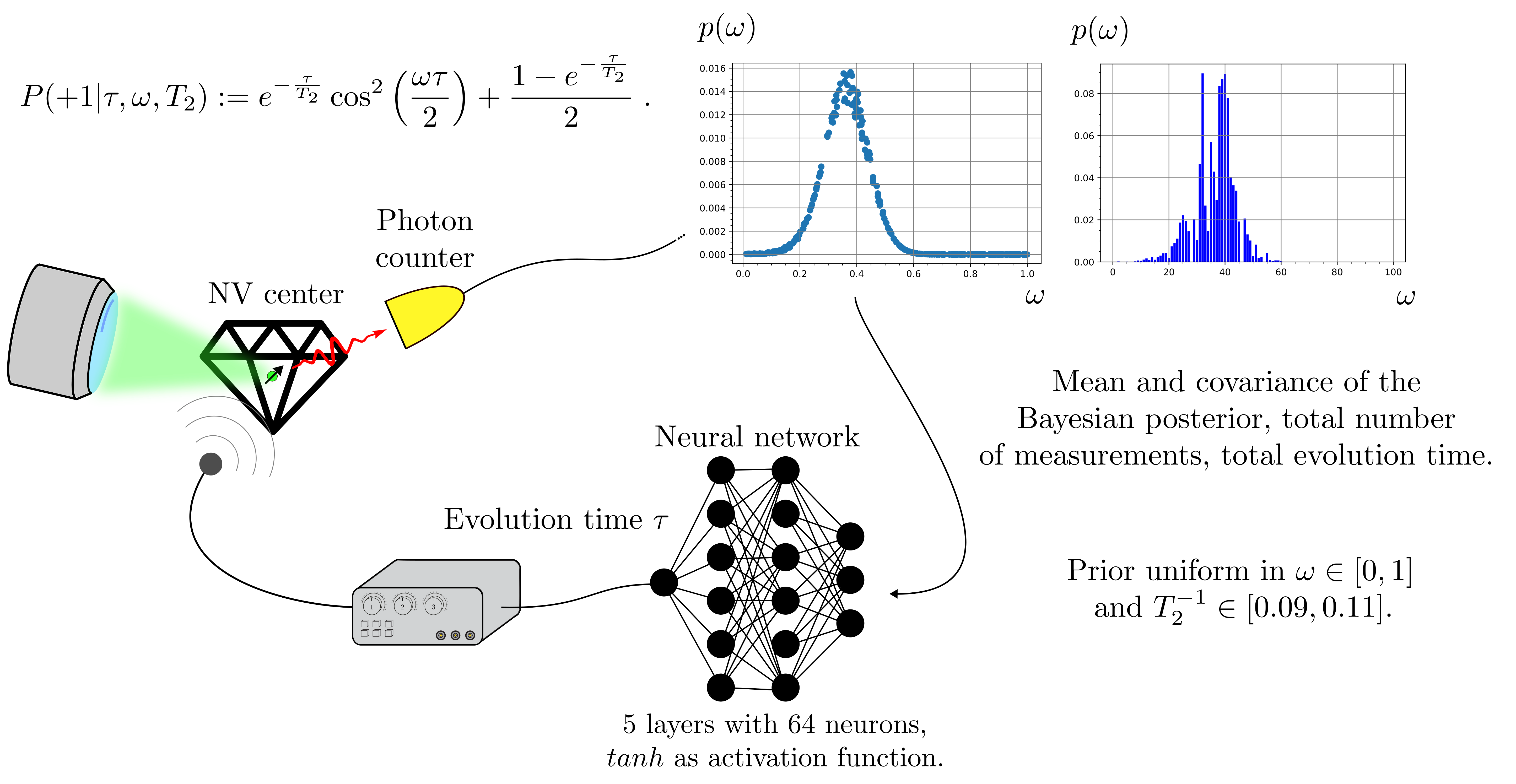
Parameters
- args:
Arguments passed to the Python script.
- batchsize: int
Batchsize of the simulation, i.e. number of estimations executed simultaneously.
- max_res: float
Maximum amount of resources allowed to be consumed in the estimation.
- learning_rate: float = 1e-2
Initial learning rate for the neural network. The initial learning rate of the static strategy is fixed to 1e-1. They both decay with
InverseSqrtDecay.- gradient_accumulation: int = 1
Flag of the
train()function.- cumulative_loss: bool = False
Flag
cumulative_loss.- log_loss: bool = False
Flag
log_loss.- res: {“meas”, “time”}
Type of resource for the simulation. It can be either the number of measurements or the total evolution time.
- invT2: float, optional
Inverse of the transversal relaxation time. If
or it is unknown and must be estimated, this parameter should not be passed.
- invT2_bound: Tuple[float, float], optional
Extrema of the uniform prior for the Bayesian estimation of the inverse of the transversal relaxation time.
- cov_weight_matrix: List, optional
Weight matrix for the mean square error on the frequency and on the inverse of the coherence time
.
- omega_bounds: Tuple[float, float] = (0.0, 1.0)
Extrema of admissible values for the precession frequency.
NV center - Phase control
- class NVCenterDCMagnPhase(batchsize: int, params: List[Parameter], prec: Literal['float64', 'float32'] = 'float64', res: Literal['meas', 'time'] = 'meas', invT2: Optional[float] = None)
Bases:
NVCenterModel describing the estimation of a static magnetic field with an NV center used as magnetometer. The transversal relaxation time
can be either known, or be a parameter to estimate. The estimation will be formulated in terms of the precession frequency
of the NV center, which is proportional to the magnetic field
. With respect to the
nv_center_dcmodule we add here the possibility of imprinting an arbitrary phase on the NV-center state before the photon counting measurement.Constructor of the
NVCenterDCMagnPhaseclass.Parameters
- batchsize: int
Batchsize of the simulation, i.e. number of estimations executed simultaneously.
- params: List[
Parameter] List of unknown parameters to estimate in the NV center experiment, with their respective bounds. This contains either the precession frequency only or the frequency and the inverse coherence time.
- prec{“float64”, “float32”}
Precision of the floating point operations in the simulation.
- res: {“meas”, “time”}
Resource type for the present metrological task, can be either the total evolution time, i.e. time, or the total number of measurements on the NV center, i.e. meas.
- invT2: float, optional
If this parameter is specified only the precession frequency
is considered as an unknown parameter, while the inverse of the transverse relaxation time
is fixed to the value invT2. In this case the list params must contain a single parameter, i.e. omega. If no invT2 is specified, it is assumed that it is an unknown parameter that will be estimated along the frequency in the Bayesian procedure. In this case params must contain two objects, the second of them should be the inverse of the transversal relaxation time.
- model(outcomes: Tensor, controls: Tensor, parameters: Tensor, meas_step: Tensor, num_systems: int = 1) Tensor
Model for the outcome of a measurement on a NV center that has been precessing in a static magnetic field. The probability of getting the outcome
is
(62)
The evolution time
and the phase
are controlled by the trainable agent, and
is the unknown precession frequency, which is proportional to the magnetic field. The parameter
may or may not be an unknown in the estimation, according to the value of the attribute invT2 of the
NVCenterDCMagnPhaseclass.
- main()
Runs the same simulations done by Fiderer, Schuff and Braun 1 but with the possibility of controlling the phase of the NV center before the Ramsey measurement.
The performances of the optimized neural network and the static strategy are reported in the following plots, together with other strategies commonly used in the literature. The resource can be either the total number of measurements or the total evolution time. Beside the NN optimized to control
and
, the performances of the NN trained to control only the evolution time
are reported in brown.
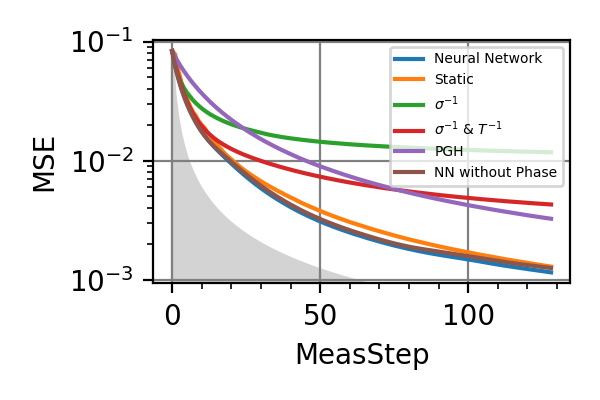
Fig. 9 invT2=0.1, Meas=128
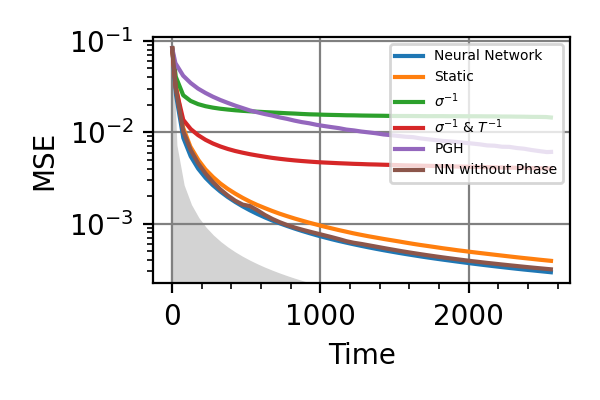
Fig. 10 invT2=0.1, Time=2560
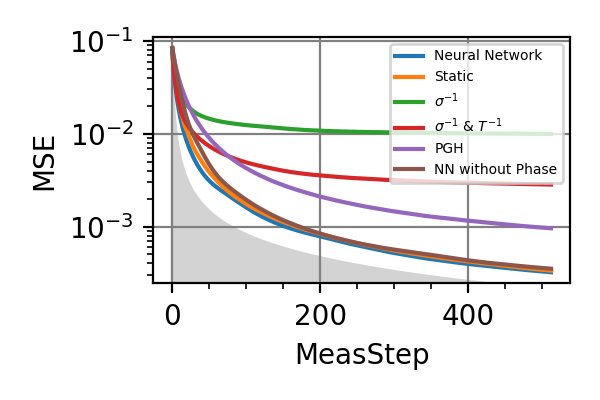
Fig. 11 invT2 in (0.09, 0.11), Meas=512
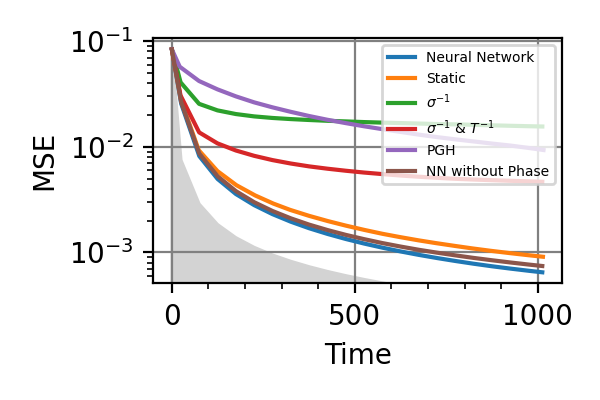
Fig. 12 invT2 in (0.09, 0.11), Time=1024
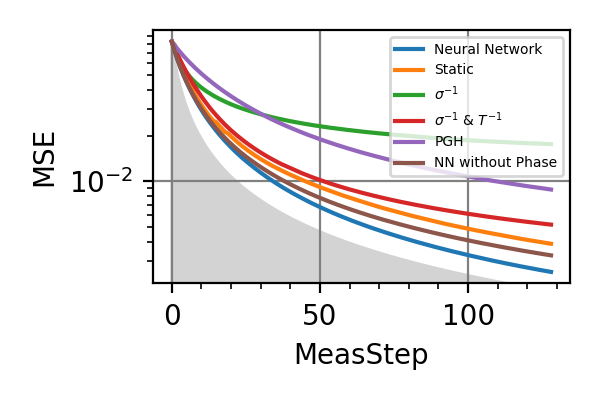
Fig. 13 invT2=0.2, Meas=128

Fig. 14 invT2=0.2, Time=2560
The shaded grey areas in the above plot indicate the Bayesian Cramér-Rao bound, which is the the ultimate precision bound computed from the Fisher information.
There is only a very small advantage in controlling the phase for
, if there is any at all. Similarly, with
no advantage has been found. For
and Time=2560 the phase control had converged to
, and more training could not take it out of this minimum. For
the advantage in introducing also the phase control becomes more consistent.
Notes
For the phase control be advantageous, the phase
must be known to some extent. While the error on
goes down, the evolution time increases, so that the error on
doesn’t go to zero. This limits the utility of controlling the phase in DC magnetometry.
All the training of this module have been done on a GPU NVIDIA Tesla V100-SXM2-32GB, each requiring
hours.
- parse_args()
Arguments
- scratch_dir: str
Directory in which the intermediate models should be saved alongside the loss history.
- trained_models_dir: str = “./nv_center_dc_phase/trained_models”
Directory in which the finalized trained model should be saved.
- data_dir: str = “./nv_center_dc_phase/data”
Directory containing the csv files produced by the
performance_evaluation()and thestore_input_control()functions.- prec: str = “float32”
Floating point precision of the whole simulation.
- n: int = 64
Number of neurons per layer in the neural network.
- num_particles: int = 480
Number of particles in the ensemble representing the posterior.
- iterations: int = 32768
Number of training steps.
- scatter_points: int = 32
Number of points in the Resources/Precision csv produced by
performance_evaluation().
- static_field_estimation(args, batchsize: int, max_res: float, learning_rate: float = 0.01, gradient_accumulation: int = 1, cumulative_loss: bool = False, log_loss: bool = False, res: Literal['meas', 'time'] = 'meas', invT2: Optional[float] = None, invT2_bound: Optional[Tuple] = None, cov_weight_matrix: Optional[List] = None, omega_bounds: Tuple[float, float] = (0.0, 1.0))
Simulates the Bayesian estimation of a static magnetic field with an NV center, for a neural network controlling the sensor, a static strategy, two variations of the
strategy, and the particle guess heuristic (PGH). Beside the evolution time also the phase is be controlled by the agent.
Parameters
- args:
Arguments passed to the Python script.
- batchsize: int
Batchsize of the simulation, i.e. number of estimations executed simultaneously.
- max_res: float
Maximum amount of resources allowed to be consumed in the estimation.
- learning_rate: float = 1e-2
Initial learning rate for the neural network. The initial learning rate of the static strategy is fixed to 1e-1. They both decay with
InverseSqrtDecay.- gradient_accumulation: int = 1
Flag of the
train()function.- cumulative_loss: bool = False
Flag
cumulative_loss.- log_loss: bool = False
Flag
log_loss.- res: {“meas”, “time”}
Type of resource for the simulation. It can be either the number of Ramsey measurements or the total evolution time.
- invT2: float, optional
Inverse of the transversal relaxation time. If
or it is unknown and must be estimated, this parameter should not be passed.
- invT2_bound: Tuple[float, float], optional
Extrema of the uniform prior for the Bayesian estimation of the inverse of the transversal relaxation time.
- cov_weight_matrix: List, optional
Weight matrix for the mean square error on the frequency and on the inverse of the coherence time
.
- omega_bounds: Tuple[float, float] = (0.0, 1.0)
Extrema of admissible values for the precession frequency.
NV center - AC Magnetometry
- class NVCenterACMagnetometry(batchsize: int, params: List[Parameter], omega: float = 0.2, prec: Literal['float64', 'float32'] = 'float64', res: Literal['meas', 'time'] = 'meas', invT2: Optional[float] = None)
Bases:
NVCenterThis model describes the estimation of the intensity of oscillating magnetic field of known frequency with an NV center used as magnetometer. The transversal relaxation time
can be either known, or be a parameter to estimate.
Constructor of the
NVCenterACMagnetometryclass.Parameters
- batchsize: int
Batchsize of the simulation, i.e. number of estimations executed simultaneously.
- params: List[
Parameter] List of unknown parameters to estimate in the NV center experiment, with their respective bounds. This contains either the field intensity
only or
and the inverse coherence time
.
- omega: float = 0.2
Frequency of the oscillating magnetic field to be estimated.
- prec{“float64”, “float32”}
Precision of the floating point operations in the simulation.
- res: {“meas”, “time”}
Resource type for the present metrological task, can be either the total evolution time, i.e. time, or the total number of measurements on the spin, i.e. meas.
- invT2: float, optional
If this parameter is specified the estimation is performed only for the field intensity
while the inverse of the transverse relaxation time
is fixed to the value invT2. In this case the list params must contain a single parameter. If no invT2 is specified, it is assumed that it is an unknown parameter that will be estimated along
by the Bayesian procedure. In this case params must contain two objects, the second of them should be the inverse of the transversal relaxation time.
- model(outcomes: Tensor, controls: Tensor, parameters: Tensor, meas_step: Tensor, num_systems: int = 1)
Model for the outcome of a measurement on a spin that has been precessing in an oscillating magnetic field of intensity
and known frequency omega. The probability of getting the outcome
is
(63)
The evolution time
is controlled by the trainable agent, and
is the unknown magnetic field. The parameter
may or may not be an unknown in the estimation, according to the value of the attribute invT2 of the
NVCenterACMagnetometryclass.
- alternate_field_estimation(args, batchsize: int, max_res: float, learning_rate: float = 0.01, gradient_accumulation: int = 1, cumulative_loss: bool = False, log_loss: bool = False, res: Literal['meas', 'time'] = 'meas', omega: float = 0.2, invT2: Optional[float] = None, invT2_bound: Optional[Tuple] = None, cov_weight_matrix: Optional[List] = None, B_bounds: Tuple[float, float] = (0.0, 1.0))
Simulates the Bayesian estimation of the intensity of an oscillating magnetic field of known frequency with an NV center sensor, for a neural network controlling the evolution time, a static strategy, two variations of the
strategy, and the particle guess heuristic (PGH).
The measurement loop is showed in the following picture.
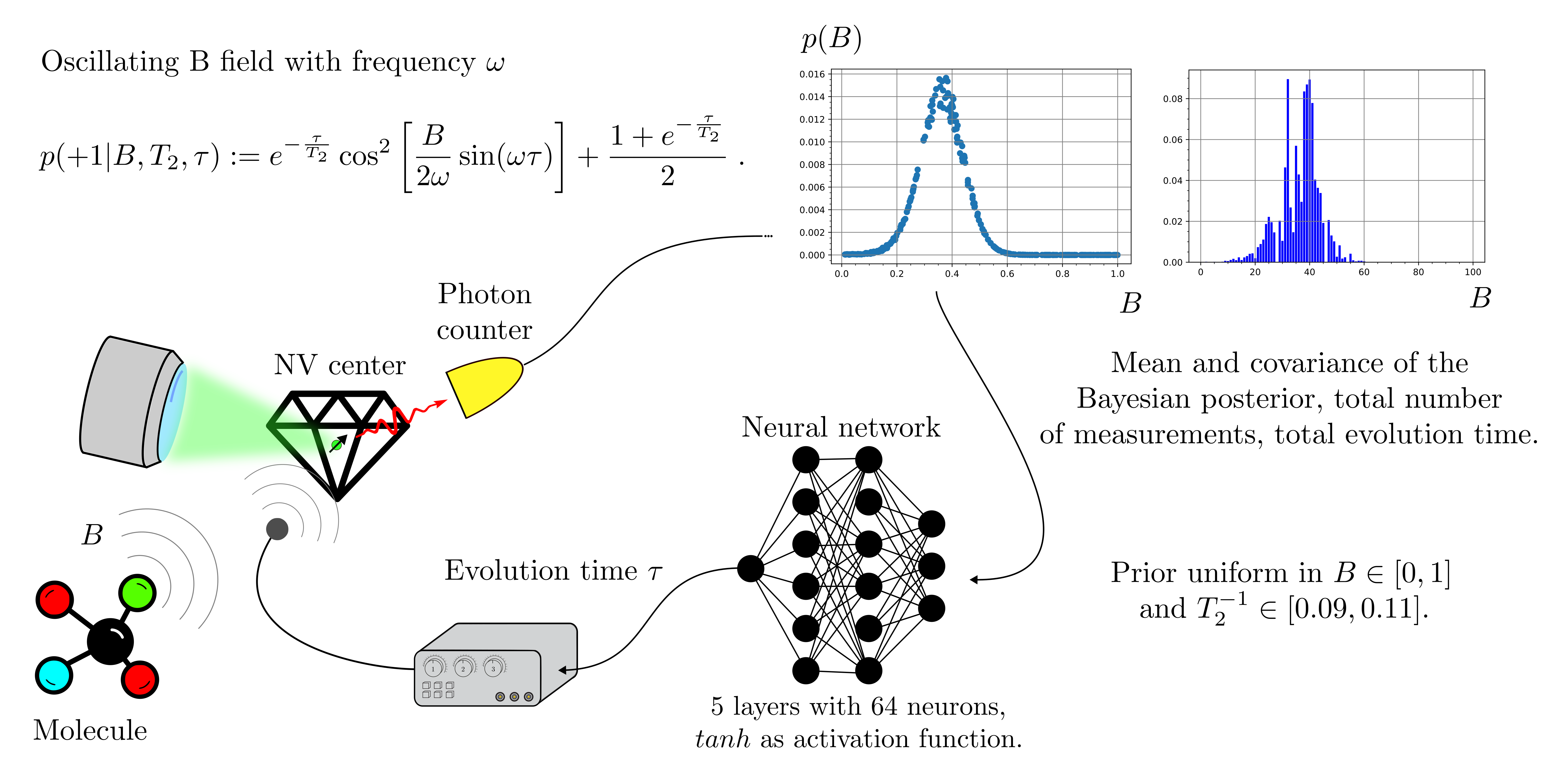
Parameters
- args:
Arguments passed to the Python script.
- batchsize: int
Batchsize of the simulation, i.e. number of estimations executed simultaneously.
- max_res: float
Maximum amount of resources allowed to be consumed in the estimation.
- learning_rate: float = 1e-2
Initial learning rate for the neural network. The initial learning rate of the static strategy is fixed to 1e-1. They both decay with
InverseSqrtDecay.- gradient_accumulation: int = 1
Flag of the
train()function.- cumulative_loss: bool = False
Flag
cumulative_loss.- log_loss: bool = False
Flag
log_loss.- res: {“meas”, “time”}
Type of resource for the simulation. It can be either the number of measurements or the total evolution time.
- omega: float = 0.2
Known frequency of the oscillating magnetic field.
- invT2: float, optional
Inverse of the transversal relaxation time. If it is infinity or it is unknown and must be estimated, this parameter should not be passed.
- invT2_bound: Tuple[float, float], optional
Extrema of admissible values of the inverse of the transversal relaxation time, whose precise value is not known before the estimation.
- cov_weight_matrix: List, optional
Weight matrix for the mean square error on the field intensity and on the decoherence parameter.
- B_bounds: Tuple[float, float] = (0.0, 1.0)
Extrema of admissible values for the intensity of the magnetic field.
- main()
Runs the simulations for the estimation of the intensity of an oscillating magnetic field of known frequency, for the same parameters of the simulations done by Fiderer, Schuff and Braun 1,
The performances of the optimized neural network and static strategies are reported in the following plots, together with the simulated
and PGH strategies, for a range of resources and coherence times. The resource can be either the total evolution time or the total number of measurements.
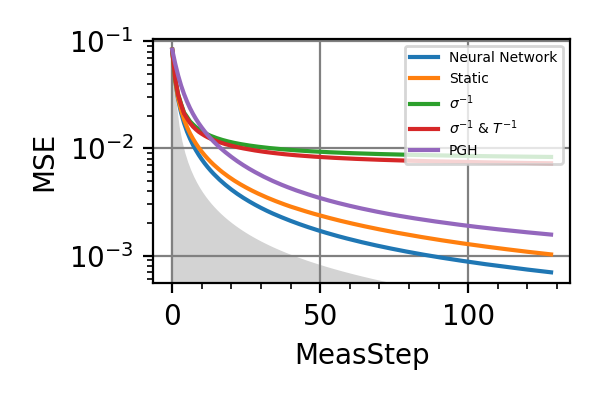
Fig. 15 invT2=0.01, Meas=128
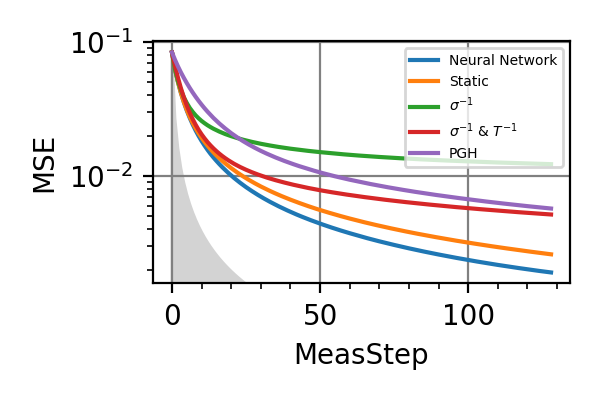
Fig. 16 invT2=0.1, Meas=128
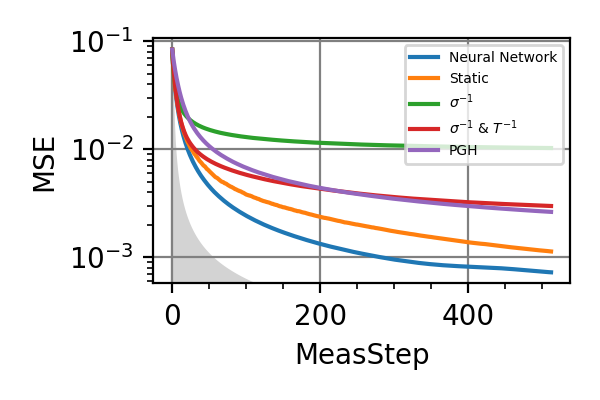
Fig. 17 invT2 in (0.09, 0.11), Meas=512
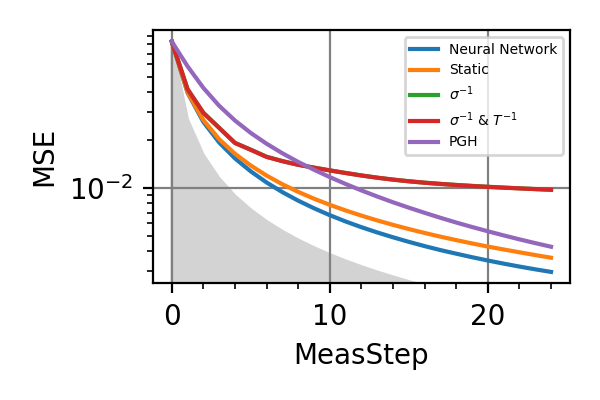
Fig. 18 invT2=0, Meas=24
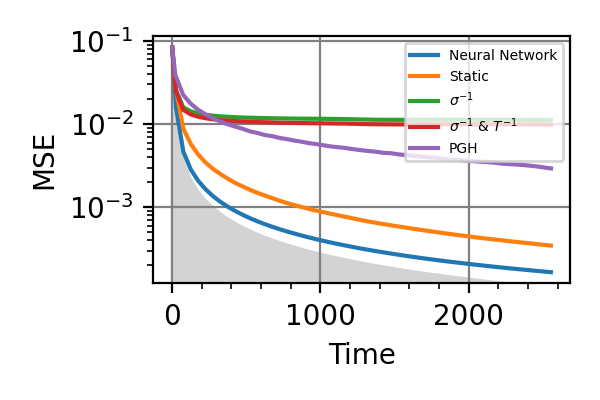
Fig. 19 invT2=0.01, Time=2560
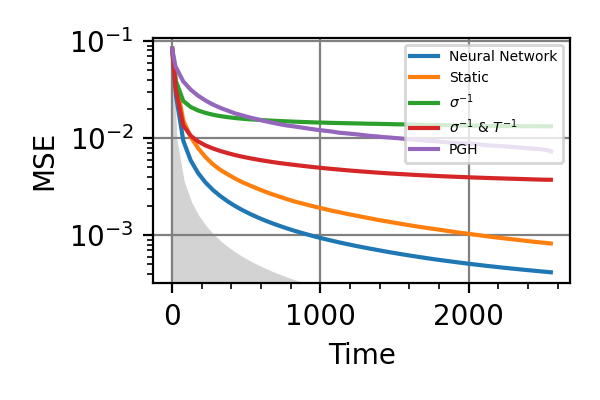
Fig. 20 invT2=0.1, Time=2560
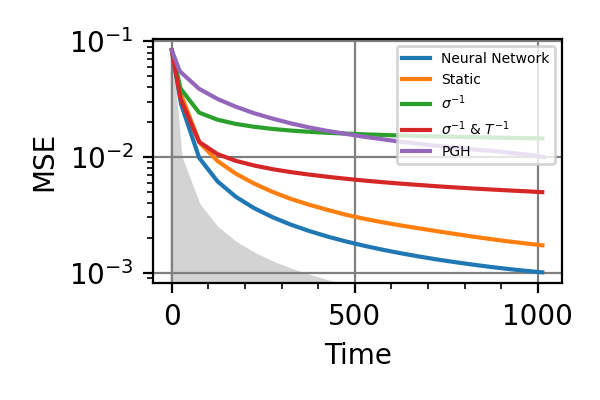
Fig. 21 invT2 in (0.09, 0.11), Time=1024
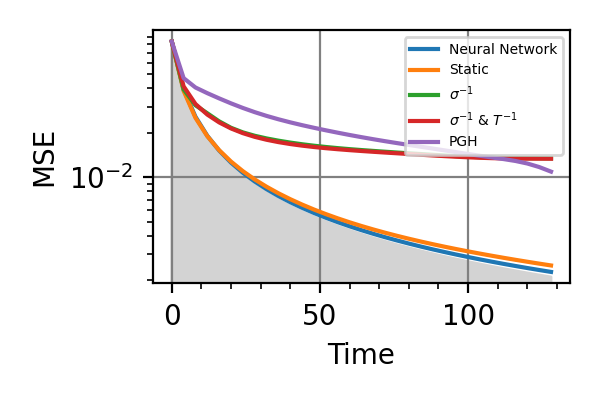
Fig. 22 invT2=0, Time=128
The shaded grey areas in the above plot indicate the Bayesian Cramér-Rao bound, which is the the ultimate precision bound computed from the Fisher information.
In all simulations we see that an “adaptivity-gap” opens between the precision of the static and the NN strategies as the resources grow.
Notes
The model used in this example is formally equivalent to that of the
nv_center_dcmodule, where the adaptive strategy gives only small advantages, at difference with the results obtained hare for AC-magnetometry. This is because the AC model maps to the DC one in a very different region of parameters with respect to the region we have explored innv_center_dc.In AC magnetometry the technique of dynamical decoupling (DD) is often used to improve the sensitivity with respect to
and to increase the coherence time
. This consists in series of
-pulses that reverse the sign of the accumulated phase. Given
the times at which the instantaneous
-pulse are applied, the outcome probability for a noiseless estimation is given by
(64)
with
being the number of pulses, and
and
being respectively the initialization and the measurement times.
In the simulations done we have used no
-pulse, but optimizing their application is the natural extension of this example, left for future works. For controlling the pulses there are possibilities:
the interval between the pulses is fixed to
, which is produced by a NN together with the number of pulses N,
the controls are the
time intervals
. The number of pulses is fixed but they can be made ineffective with
,
the control is the free evolution time
together with a boolean variable, that tells whether a pulse or a measurement has to be applied after the free evolution. This would require a stateful model for the NV center, where the current phase is the state.
The problem of estimating
knowing the frequency is complementary to the protocol for the optimal discrimination of frequencies presented in 3, which is used to distinguish chemical species in a sample. In this work the authors put forward an optimal strategy for the discrimination of two frequencies
and
, knowing the intensity
. If
and the field intensity is unknown a two stage approach to the problem is possible. We can estimate
as done in this example, i.e. by considering the frequency fixed to
, and then proceed with the optimal frequency discrimination based on the intensity just estimated. The error probability of the second stage depends on the precision of the first. Given a fixed total time for the discrimination, the time assigned to the first and the second stage can be optimized to minimize the final error. For close frequencies we expect this two stage protocol to be close to optimality. A small improvement would be to simulate the estimation of
with the frequency as a nuisance parameters. It is important for the first stage, the estimation of the field intensity, to have low sensitivity to variations in the frequency. For optimizing frequency discrimination with
as a nuisance parameter in a fully integrated protocol the introduction of
-pulses is necessary, just like for dynamical decoupling. The natural extension of hypothesis testing on the frequency is the estimation of both the intensity and the frequency of the magnetic field optimally, both starting from a broad prior. All these improvements are left for future work.
All the training of this module have been done on a GPU NVIDIA Tesla V100-SXM2-32GB, each requiring
hours.
- 3
Schmitt, S., Gefen, T., Louzon, D. et al. npj Quantum Inf 7, 55 (2021).
- parse_args()
Arguments
- scratch_dir: str, required
Directory in which the intermediate models should be saved alongside the loss history.
- trained_models_dir: str = “./nv_center_ac/trained_models”
Directory in which the finalized trained model should be saved.
- data_dir: str = “./nv_center_ac/data”
Directory containing the csv files produced by the
performance_evaluation()and thestore_input_control()functions.- prec: str = “float32”
Floating point precision of the whole simulation.
- n: int = 64
Number of neurons per layer in the neural network.
- num_particles: int = 480
Number of particles in the ensemble representing the posterior.
- iterations: int = 32768
Number of training steps.
- scatter_points: int = 32
Number of points in the Resources/Precision csv produced by
performance_evaluation().
NV center - Hyperfine coupling
- class NVCenterHyperfine(batchsize: int, params: List[Parameter], prec: Literal['float64', 'float32'] = 'float64', res: Literal['meas', 'time'] = 'meas', invT2: float = 0.0)
Bases:
NVCenterThis class models the measurement of an NV center strongly coupled to a 13C nuclear spin in the diamond lattice. Such nuclear spin is not hidden in the spin bath of nuclei, that causes the dephasing noise, instead it splits the energy levels of the NV center, according to the hyperfine interaction strength. The precession frequency of the NV center in a magnetic field is determined by the state of the nuclear spin. In the work of T. Joas et al. 4 multiple incoherent nuclear spin flips happen during the read out, so that the nuclear spin is in each eigenstate approximately half of the time. This motivates the choice for the outcome probability of Ramsey measure on the NV center:
(65)
In such model
and
are the two precession frequencies of the sensor to be estimated, splitted by the hyperfine interaction,
is the coherence time,
and
are the controls, being respectively the evolution time and the phase.
Notes
This models is completely symmetric under permutation of the two precession frequencies. In these cases the flag
permutation_invariantmust be activated. Only those weight matrices that are permutationally invariant should be considered for the estimation.All the training of this module have been done on a GPU NVIDIA Tesla V100-SXM2-32GB, each requiring
hours.
- 4
Joas, T., Schmitt, S., Santagati, R. et al. npj Quantum Inf 7, 56 (2021).
Constructor of the
NVCenterHyperfineclass.Parameters
- batchsize: int
Batchsize of the simulation, i.e. number of estimations executed simultaneously.
- params: List[
Parameter] List of unknown parameters to estimate in the NV center experiment, with their respective bounds. These are the two precession frequencies
and
.
- prec{“float64”, “float32”}
Precision of the floating point operations in the simulation.
- res: {“meas”, “time”}
Resource type for the present metrological task, can be either the total evolution time, i.e. time, or the total number of measurements on the NV center, i.e. meas.
- invT2: float = 0.0
The inverse of the transverse relaxation time
is fixed to the value invT2.
- model(outcomes: Tensor, controls: Tensor, parameters: Tensor, meas_step: Tensor, num_systems: int = 1) Tensor
Model for the outcome probability of the NV center subject to the hyperfine interaction with the carbon nucleus and measured through photoluminescence after a Ramsey sequence. The probability of getting +1 in the majority voting following the photon counting is given by Eq.65.
Notes
There is also another way of expressing the outcome probability of the measurement. Instead of defining the model in terms of
and
we could define it in terms of the frequency sum
and frequency difference
, thus writing
(66)
In this form there is no permutational invariance in
and
, instead the model is invariant under the transformation
. We should choose a prior having
, which means
. We could impose the positivity of the frequencies by requiring
in the prior.
- hyperfine_parallel_estimation(args, batchsize: int, max_res: float, learning_rate: float = 0.01, gradient_accumulation: int = 1, cumulative_loss: bool = False, log_loss: bool = False, res: Literal['meas', 'time'] = 'meas', invT2: Optional[float] = None, cov_weight_matrix: Optional[List] = None, omega_bounds: Tuple[float, float] = (0.0, 1.0))
Estimation of the frequencies of two hyperfine lines in the spectrum of an NV center strongly interacting with a 13C nuclear spin. The mean square errors of the two parameters are weighted equally with
. The frequency difference is the component of the hyperfine interaction parallel to the NV center quantization axis, i.e.
. The priors for
and
are both uniform in (0, 1), and they are symmetrized. Beside the NN and the static strategies, the performances of the particle guess heuristic (PGH), and of the
strategies are reported in the plots. These other strategies are explained in the documentation of the
Magnetometryclass. The picture represent a schematic of the estimation of the hyperfine coupling controlled by the NN.
- main()
In the following we report the mean square error on the Bayesian estimators for the two frequencies for different strategies and different coherence times
. The resource is either the total evolution time or the number of measurements on the NV center.
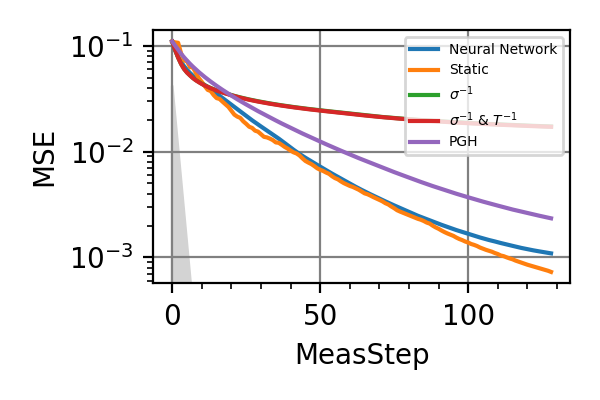
Fig. 23 invT2=0, Meas=128
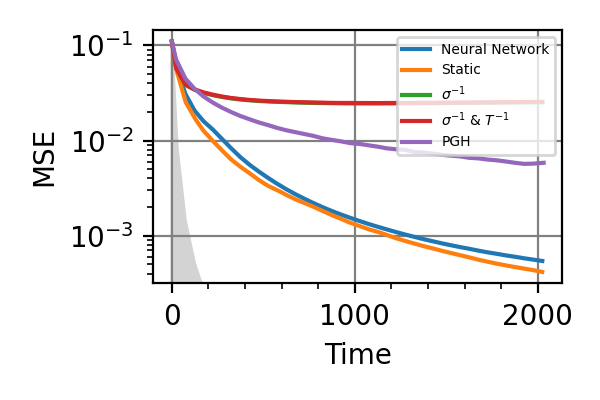
Fig. 24 invT2=0, Time=2048
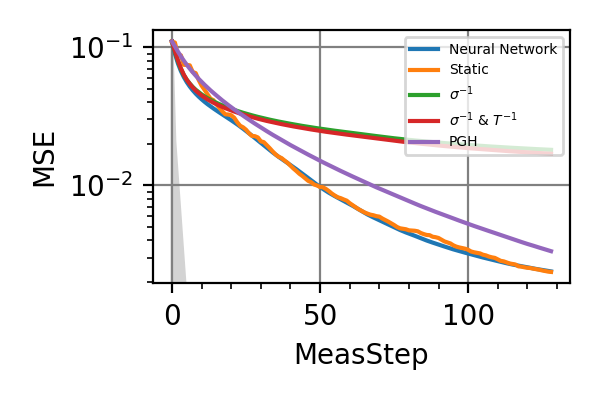
Fig. 25 invT2=0.01, Meas=128
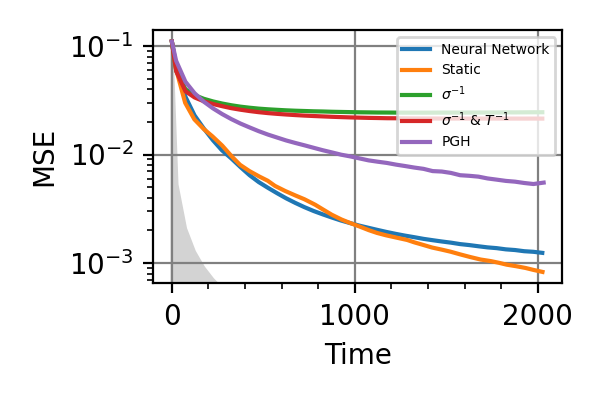
Fig. 26 invT2=0.01, Time=2048
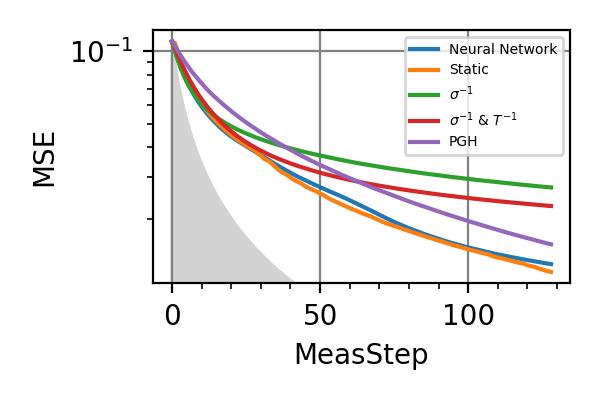
Fig. 27 invT2=0.1, Meas=128
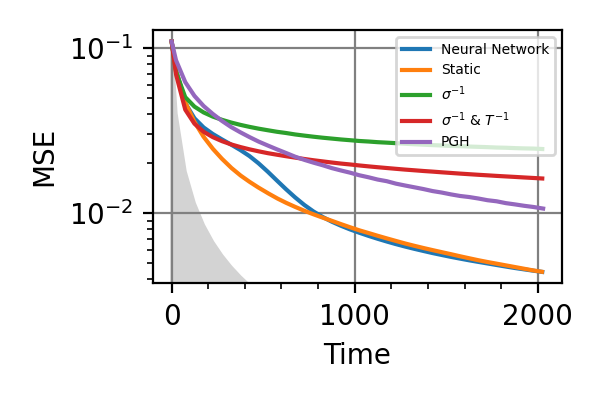
Fig. 28 invT2=0.1, Time=2048
The shaded grey areas in the above plot indicate the Bayesian Cramér-Rao bound, which is the the ultimate precision bound computed from the Fisher information.
From these simulations there seems to be no significant advantage in using an adaptive strategy for the simultaneous estimation of the two precession frequencies. Neither for large nor for small coherence times
.
Notes
In a future work the alternative model of Eq.66 should be implemented. Being interested in the difference
, the sum of the frequencies would be treated as a nuisance parameter.
The absence on an advantage of the adaptive strategy over the non-adaptive one is probably also due to the hyper-simplified information passed to the neural network. We are in fact approximating a complex 2D posterior, with many peaks and valleys with a Gaussian. A better approach would be to train an autoencoder to compress the information contained in the posterior and pass it to the NN. The autoencoder will be trained to compress that class of distribution which are produced by the likelihood of the double precession frequency model.
All the simulations of this module have been done on a GPU NVIDIA GeForce RTX-4090-24GB.
- parse_args()
Arguments
- scratch_dir: str
Directory in which the intermediate models should be saved alongside the loss history.
- trained_models_dir: str = “./nv_center_double/trained_models”
Directory in which the finalized trained model should be saved.
- data_dir: str = “./nv_center_double/data”
Directory containing the csv files produced by the
performance_evaluation()and thestore_input_control()functions.- prec: str = “float32”
Floating point precision of the whole simulation.
- n: int = 64
Number of neurons per layer in the neural network.
- num_particles: int = 4096
Number of particles in the ensemble representing the posterior.
- iterations: int = 4096
Number of training steps.
NV center - Decoherence
- class DecoherenceSimulation(particle_filter: ParticleFilter, phys_model: NVCenterDecoherence, control_strategy: Callable, simpars: SimulationParameters, cov_weight_matrix: Optional[List] = None, random: bool = False, median: bool = False, loss_normalization: bool = False)
Bases:
StatelessMetrologyThis class does the same job of
StatelessMetrology, but it can append a randomly generated control time to the input_strategy Tensor produced by thegenerate_input()method and it can compute the median square error (MedianSE) instead of the mean square error (MSE) in theloss_function()method.Parameters passed to the constructor of the
DecoherenceSimulationclass.Parameters
- particle_filter:
ParticleFilter Particle filter responsible for the update of the Bayesian posterior on the parameters.
- phys_model:
NVCenterDecoherence Abstract description of the NC center for the characterization of the dephasing noise.
- control_strategy: Callable
Callable object (normally a function or a lambda function) that computes the values of the controls for the next measurement from the Tensor input_strategy, which is produced by the method
generate_input().- simpars:
SimulationParameters Contains the flags and parameters that regulate the stopping condition of the measurement loop and modify the loss function used in the training.
- cov_weight_matrix: List, optional
Positive semidefinite weight matrix. If this parameter is not passed then the default weight matrix is the identity, i.e.
.
- random: bool = False
If this flag is True then a randomly chosen evolution time
is added to the input_strategy Tensor produced by
generate_input().- median: bool = False
If this flag is True, then instead of computing the mean square error (MSE) from a batch of simulation the median square error (MedianSE) is computed. See the documentation of the
loss_function()method.Achtung! The median can be used in the training, however it means throwing away all the simulations in the batch except to the one that realizes the median. This is not an efficient use of the simulations in the training. When used the median should be always confined to the performances evaluation, while the training is to be carried out with the mean square error.
- loss_normalization: bool = False
If loss_normalization is True, then the loss is divided by the normalization factor
(67)
where
are the bounds of the i-th parameter in phys_model.params and
are the diagonal entries of cov_weight_matrix.
is the total elapsed evolution time, which can be different for each estimation in the batch.
Achtung! This flag should be used only if the resource is the total estimation time.
- generate_input(weights: Tensor, particles: Tensor, meas_step: Tensor, used_resources: Tensor, rangen: Generator)
This method returns the same input_strategy Tensor of the
generate_input()method, but, if the attribute random is True, an extra column is appended to this Tensor containing the randomly generated evolution time. The value of
is uniformly extracted in the interval of the admissible values for the inverse of the coherence time
.
- loss_function(weights: Tensor, particles: Tensor, true_values: Tensor, used_resources: Tensor, meas_step: Tensor)
Computes the loss for each estimation in the batch.
If median is False, then it returns the same loss of the
loss_functionmethod, i.e. the square error for each simulation in the batch, called, where
runs from
to
, with
the batchsize. If the flag median is True, this method returns the median square error of the batch, in symbols
. In order to compute it, the vector of losses
is sorted, the element at position
is then the median of the losses in the batch. Calling
the position in the unsorted batch of the simulation realizing the median, the outcome of this method is the vector
(68)
The advantage of using the median error is the reduced sensitivity to outliers with respect to the mean erro.
Achtung! Even if the performances evaluation can be performed with the median square error, the training should always minimize the mean square error.
- particle_filter:
- class NVCenterDecoherence(batchsize: int, params: List[Parameter], prec: Literal['float64', 'float32'] = 'float64', res: Literal['meas', 'time'] = 'meas')
Bases:
NVCenterModel describing an NV center subject to a variable amount of decoherence. The dephasing rate encodes some useful information about the environment, which can be recovered by estimating the transverse relaxation time and the decaying exponent.
Constructor of the
NVCenterDecoherenceclass.Parameters
- batchsize: int
Batchsize of the simulation, i.e. number of estimations executed simultaneously.
- params: List[
Parameter] List of unknown parameters to estimate in the NV center experiment, with their priors. It should contain the inverse of the characteristic time of the dephasing process, indicated with the symbol
and the exponent
of the decay. This last parameter carries information on the spectral density of the noise.
- prec{“float64”, “float32”}
Precision of the floating point operations in the simulation.
- res: {“meas”, “time”}
Resource type for the present metrological task. It can be either the total evolution time, i.e. time, or the total number of measurements on the NV center, i.e. meas.
- model(outcomes: Tensor, controls: Tensor, parameters: Tensor, meas_step: Tensor, num_systems: int = 1)
Model for the outcome of a photon counting measurement following a Ramsey sequence on the NV center sensor subject to dephasing noise. The probability of getting the outcome
is
(69)
The evolution time
is controlled by the trainable agent and
and
are the two unknown characteristic parameters of the noise. The factor 20 appearing at the exponent is just the normalization factor we used for
.
- decoherence_estimation(args, batchsize: int, max_res: float, learning_rate: float = 0.001, gradient_accumulation: int = 1, cumulative_loss: bool = True, log_loss: bool = False, res: Literal['meas', 'time'] = 'meas', loss_normalization: bool = False, beta_nuisance: bool = False, fixed_beta: bool = False)
Simulates the Bayesian estimation of the decoherence parameters of a dephasing noise acting on an NV center. The control parameter is the free evolution time of the system during the Ramsey sequence. We have implement four strategies for the control of the evolution time:
Adaptive strategy with a trained neural network on the basis of the state of the particle filter (adaptive strategy).
Static strategy implemented with a neural network that receives in input the amount of already consumed resources (time or measurements)
Random strategy, with an evolution time chosen in the admissible interval for the values of
.
Inverse time strategy. The evolution time is is
for the measurement-limited estimation and
for the time-limited estimations, where
and
. These numerical coefficients come from the optimization of the Fisher information. For the simulations where
is a nuisance parameter
is used also for the time-limited estimation.
This function trains the static and the adaptive strategies, and evaluates the error for all these four possibilities, in this order.
Achtung! In this example the static strategy is not implemented as a Tensor of controls for each individual measurement, like in the other examples. On the contrary it is implemented as a neural network that takes in input only the value of the consumed resources up to that point.
The measurement cycle is represented in the picture below.

Parameters
- args:
Arguments passed to the Python script.
- batchsize: int
Batchsize of the simulation, i.e. number of estimations executed simultaneously.
- max_res: float
Maximum amount of resources allowed to be consumed in the estimation.
- learning_rate: float = 1e-3
Initial learning rate for the neural networks, for both the adaptive and static strategies. The learning rate decays with
InverseSqrtDecay.- gradient_accumulation: int = 1
Flag of the
train()function.- cumulative_loss: bool = False
Flag
cumulative_loss.- log_loss: bool = False
Flag
log_loss.- res: {“meas”, “time”}
Type of resource for the simulation. It can be either the number of measurements or the total evolution time.
- loss_normalization: bool = False
Parameter loss_normalization passed to the constructor of the
NVCenterDecoherenceclass.- beta_nuisance: bool = False
If this flag is True, the loss is computed only from the error on the inverse decay time
.
- fixed_beta: bool = False
If this flag is True the decay exponent is set to
.
- main()
In this example we characterize the dephasing process of an NV center. We study three cases. In the first one the decaying exponent
is unknown and it is treated as a nuisance parameter. Therefore, only the precision on the inverse decay time appears in the loss (the MSE). In the second case
is known and fixed (
), and only
is estimated. In the third case both
and
are unknown and are parameters of interest, but their MSE are not evenly weighted: the error
weights half of
. This is done t equilibrate the different priors on the parameters and consider them on an equal footage.
The prior on
is uniform in (0.01, 0.1), and that of
is uniform in (0.075, 0.2) (when it is not fixed), so that the interval for the actual exponent, which is
(see
model()) is (1.5, 4) 5.In the following we report the estimator error (MSE) for a bounded number of measurement (on the left), and for a bounded total evolution time (on the right). These simulations are done by calling the function
decoherence_estimation().The adaptive and static strategies are compared with two simple choices for the controls. The first is a randomize strategy, according to which the inverse of the evolution time is randomly selected uniformly in (0.01, 0.1), while the second is a
strategy, according to which the inverse of the evolution time is chosen to be the current estimator for the inverse of the coherence time.
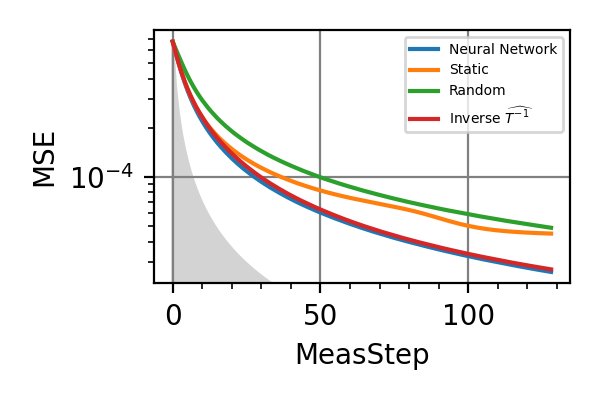
Fig. 29 Meas=128, beta nuisance
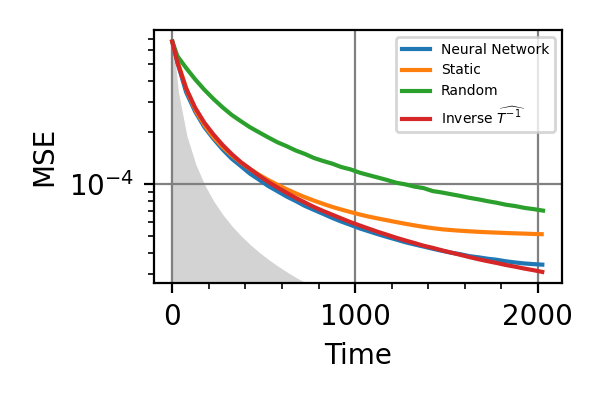
Fig. 30 Time=2048, beta nuisance
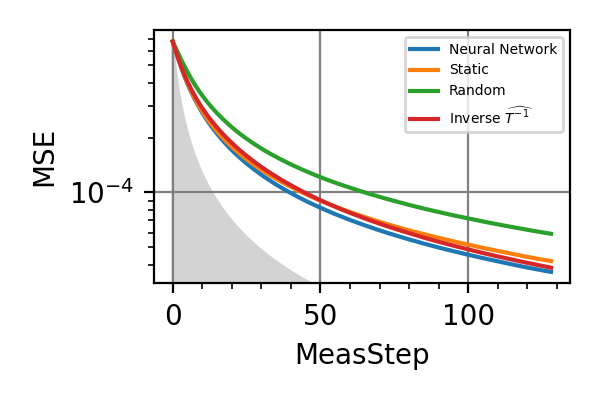
Fig. 31 Meas=128, fixed beta
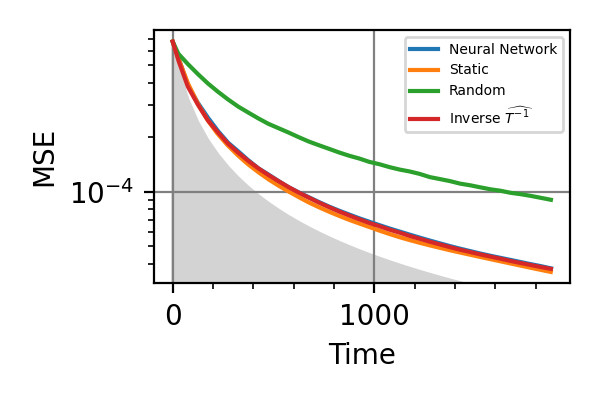
Fig. 32 Time=2048, fixed beta
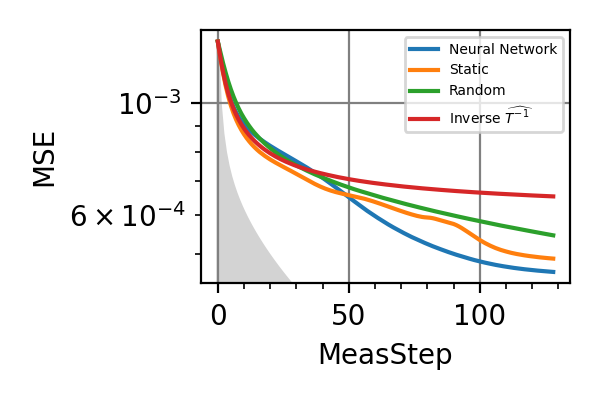
Fig. 33 Meas=128, both parameters
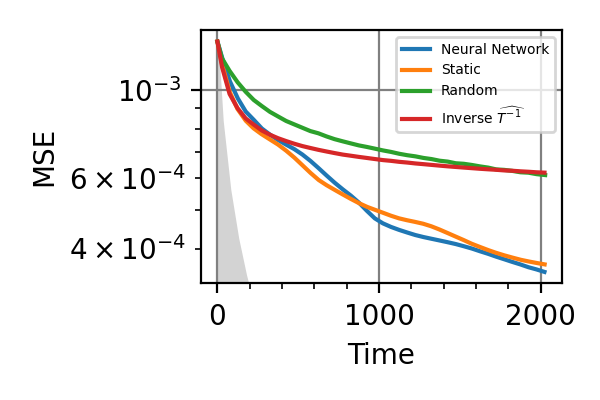
Fig. 34 Time=2048, both parameters
The shaded grey areas in the above plot indicate the Bayesian Cramér-Rao bound, which is the the ultimate precision bound computed from the Fisher information.
There is no advantage in using a NN instead of the strategies that optimize the Fisher information.
Notes
Some application of the estimation of the decoherence time involve the measure of the radical concentration in a biological sample and the measurement of the local conductivity through the Johnson noise.
All the training of this module have been done on a GPU NVIDIA Tesla V100-SXM2-32GB, each requiring
hours.
- parse_args()
Arguments
- scratch_dir: str, required
Directory in which the intermediate models should be saved alongside the loss history.
- trained_models_dir: str = “./nv_center_decoherence/trained_models”
Directory in which the finalized trained model should be saved.
- data_dir: str = “./nv_center_decoherence/data”
Directory containing the csv files produced by the
performance_evaluation()and thestore_input_control()functions.- prec: str = “float32”
Floating point precision of the whole simulation.
- n: int = 64
Number of neurons per layer in the neural network.
- num_particles: int = 2048
Number of particles in the ensemble representing the posterior.
- iterations: int = 4096
Number of training steps.
- scatter_points: int = 32
Number of points in the Resources/Precision csv produced by
performance_evaluation().
Dolinar (Dolan) receiver
- class AgnosticDolinar(batchsize: int, params: List[Parameter], n: int, resources: str = 'alpha', prec: str = 'float64')
Bases:
StatefulPhysicalModelSchematization of the agnostic Dolinar receiver 6.
The task is to discriminate between
and
, given a single copy of
and
copies of
, that have been prepared in another lab. At difference with the usual Dolinar receiver the intensity of the signal
is not known, but can be estimated from
to adapt the strategy. The physical motivations behind this model is that of a series of wires, with only one carrying the signal, subject to a loss noise of fluctuating intensity.
- 6
F. Zoratti, N. Dalla Pozza, M. Fanizza, and V. Giovannetti, Phys. Rev. A 104, 042606 (2021).
Constructor of the
AgnosticDolinarclass.Parameters
- batchsize: int
Number of agnostic Dolinar receivers simulated at the same time in a mini-batch.
- params: List[
Parameter] List of parameters. It must contain the continuous parameter alpha with its admissible range of values, and the discrete sign parameter, that can take the values (-1, +1).
- n: int
Number of states
that the agnostic Dolinar receiver consumes to make a decision on the sign of the sign of the signal.
Achtung! Note that in the simulation n+1 measurement are actually performed, because both outputs of the last beam splitter are measured.
- resources: {“alpha”, “step”}
Resources of the model, can be the amplitude
of the signal or the number of state
consumed in the procedure.
- prec: str = “float64”
Floating point precision of the model.
- count_resources(resources: Tensor, outcomes: Tensor, controls: Tensor, true_values: Tensor, state: Tensor, meas_step: Tensor) Tensor
The resources can be either the number of states
consumed, which is update after every beam splitter, or the amplitude
, that is related to the mean number of photons in the signal.
- initialize_state(parameters: Tensor, num_systems: int) Tensor
State initialization for the agnostic Dolinar receiver. The state contains the amplitude of the remaining signal after the measurements (for both hypothesis) and the total number of measured photons.
- model(outcomes: Tensor, controls: Tensor, parameters: Tensor, state: Tensor, meas_step: Tensor, num_systems: int = 1)
Probability of observing the number of photons outcomes in a photon counter measurement in the agnostic Dolinar receiver.
- perform_measurement(controls: Tensor, parameters: Tensor, true_state: Tensor, meas_step: Tensor, rangen: Generator)
The signal
and the reference states
are sequentially mixed on a beam splitter with tunable transmission
, and one output of the beam splitter is measured through photon counting, while the other gets mixed again. The left over signal after n uses of the beam splitter is then measured on a photon counter.
- class DolinarSimulation(particle_filter: ParticleFilter, phys_model: AgnosticDolinar, control_strategy: Callable, simpars: SimulationParameters, loss: int = 3)
Bases:
StatefulSimulationSimulation class for the agnostic Dolinar receiver. It works with a
ParticleFilterand aAgnosticDolinarobjects.The measurement loop is showed in the following picture.
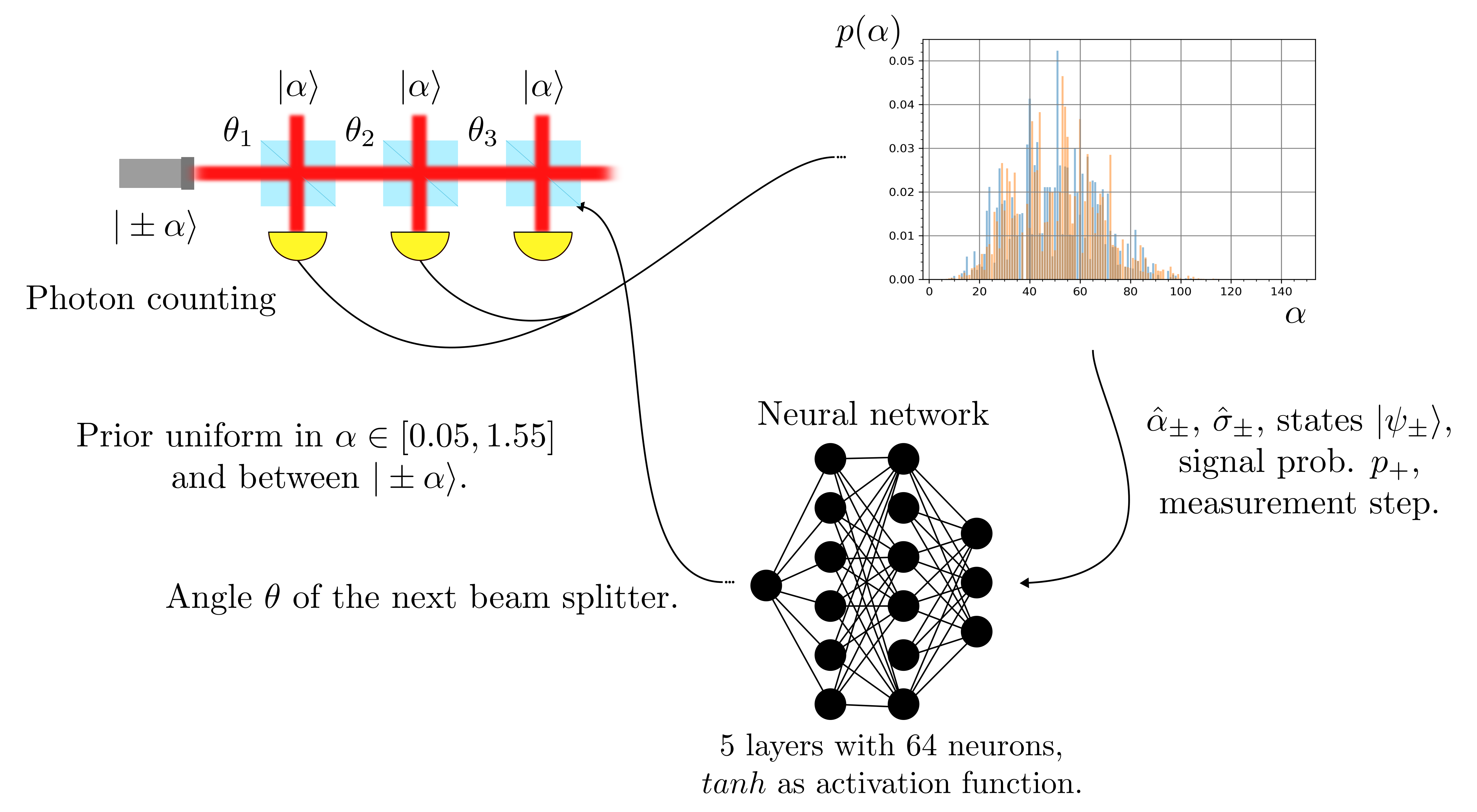
Constructor of the
DolinarSimulationclass.Parameters
- particle_filter:
ParticleFilter Particle filter responsible for the update of the Bayesian posterior on
and on the sign of the signal. It contains the methods for applying the Bayes rule and computing Bayesian estimators from the posterior.
- phys_model:
AgnosticDolinar Model of the agnostic Dolinar receiver.
- simpars:
SimulationParameters Parameter simpars passed to the class constructor.
- loss: int = 3
Type of loss to be used in the simulation. It regulates the behavior of the
loss_function()method. There are nine possible losses to choose from. These are explained in the documentation ofloss_function().
- generate_input(weights: Tensor, particles: Tensor, state_ensemble: Tensor, meas_step: Tensor, used_resources: Tensor, rangen: Generator)
This method collects the information on
and on the sign of the signal produced by the particle filter and builds from them the input_strategy object to be fed to the neural network. This Tensor has nine scalar components, that are:
, the normalized intensity of the signal after the measurements, assuming that it was
at the beginning.
, the mean posterior estimator for signal intensity assuming
.
, the variance of the posterior distribution for the signal intensity, assuming
.
, the normalized intensity of the signal after the measurements, assuming that it was
at the beginning.
, the mean posterior estimator for signal intensity assuming
.
, the variance of the posterior distribution for the signal intensity, assuming
.
the posterior probability for the original signal to be
,
the index of the current measurement meas_step normalized against the total number of measurements,
the total number of photons measured, up to the point this method is called.
- loss_function(weights: Tensor, particles: Tensor, true_state: Tensor, state_ensemble: Tensor, true_values: Tensor, used_resources: Tensor, meas_step: Tensor)
The loss of the agnostic Dolinar receiver measures the error in guessing the sign of the signal
, after the signal has been completely measured.
There are nine possible choices for the loss, which can be tuned through the parameter loss passed to the constructor of the
DolinarSimulationclass. Before analyzing one by one these losses we establish some notation.is the posterior probability that the original signal is
,
,
is the sign of the signal in
, and
is the total number of observed photons. The error probability given by the resource limited Helstrom bound is indicated with
. This is computed by the function
helstrom_bound(). We also define the Kronecker delta function(70)
There are two possible policies for guessing the signal sign, that we indicate respectively with
and
. They are respectively
(71)
and
(72)
The possible choices for the loss are
loss=0:
,
loss=1:
,
loss=2:
,
loss=3:
,
loss=4:
,
loss=5:
,
loss=6:
,
loss=7:
,
loss=8:
,
Notes
The optimization with loss=3 works better for small
then for large
. This is because the scalar loss is the mean of the error probability on the batch and it is not so relevant to optimize the estimations those regions of the parameter
that have low error probability anyway. To summarize, loss=3 makes the optimization concentrate on the region of small
, since this region dominates the error.
Achtung!: A constant added to the loss is not irrelevant for the training, since the loss itself and not only the gradient is appears in the gradient descent update.
- particle_filter:
- dolinar_receiver(args, num_steps: int, loss: int = 3, learning_rate: float = 0.01)
Training and performance evaluation of the neural network and the static strategies that control the beam splitter reflectivity in the agnostic Dolinar receiver.
Parameters
- args:
Arguments passed to the Python script.
- num_steps: int
Number of reference states
in the Dolinar receiver.
- loss: int = 3
Type of loss used for the training, among the ones described in the documentation of
loss_function(). The loss used for the performances evaluation is always loss=0.- learning_rate: float = 1e-2
Initial learning rate for the neural network. The initial learning rate of the static strategy is fixed to 1e-2. They both decay with
InverseSqrtDecay.
- helstrom_bound(batchsize: int, n: int, alpha: Tensor, iterations: int = 200, prec: str = 'float64')
Calculates the Helstrom bound for the agnostic Dolinar receiver with n copies of
. It is the lower bound on the error probability for the discrimination task and it is given by the formula
(73)
where
is the probability distribution of a Poissonian variable, i.e.
(74)
Parameters
- batchsize: int
Number of bounds to be computed simultaneously, it is the first dimension of the alpha Tensor.
- n: int
Number of copies of
at disposal.
- alpha: Tensor
Tensor of shape (batchsize, 1), with the amplitudes of the coherent states for each discrimination task.
- iterations: int = 200
There is no closed formula for the error probability, this parameter is the number of summand to be computed in Eq.73.
- prec: str = “float64”
Floating point precision of the alpha parameter.
Returns
- Tensor:
Tensor of shape (batchsize, 1) and type prec containing the evaluated values of the Helstrom error probability for the discrimination taks.
- main()
We have trained the optimal adaptive and static strategies for the agnostic Dolinar receiver.
The error probabilities as a function of
are reported in the following figure for
and
reference states
, for two different training losses (loss=3 and loss=6).
The Heterodyne and Photon counting are two 2-stage adaptive strategies based on first measuring all the reference state
and then trying to discriminate the signal based on the acquired information 5.
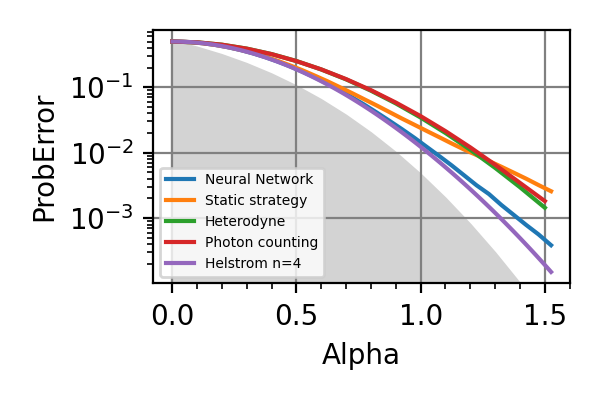
Fig. 35 n=4, loss=3
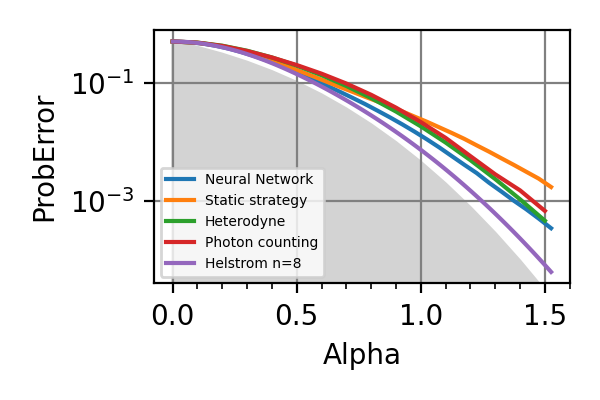
Fig. 36 n=8, loss=3
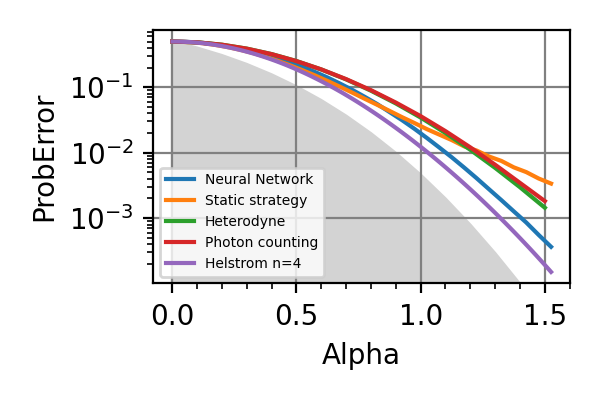
Fig. 37 n=4, loss=6
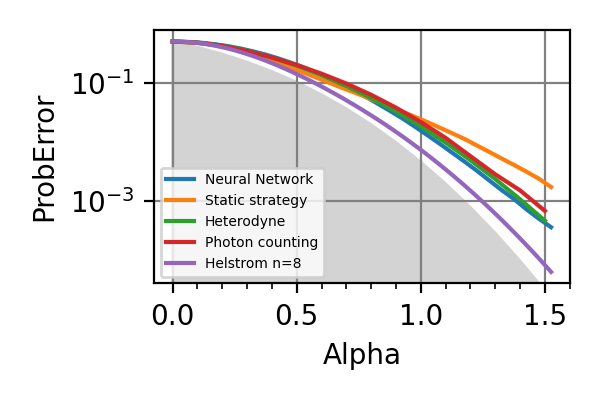
Fig. 38 n=8, loss=6
The shaded grey areas in the above plot indicate the Helstrom bound for the discrimination of
.
The loss=3 seems to be uniformly superior to loss=6 for every value of
. The advantage of using the neural network strategy is very contained with respect to already known strategies for
but it is significant for
. Instead of a NN a decision tree could have also been a viable strategy for controlling the beam splitters as done in the module
dolinar_three. As expected the gap between the precision of the adaptive and of the non-adaptive strategies increases with the number of photons in the signal.Notes
The loss used in calling
performance_evaluation()is always loss=0.The resources used in calling
store_input_control()are always the number of measurements.An application of machine learning (decision trees) to the Dolinar receiver have been presented also by Cui et al 7.
Known bugs: the training on the GPU freezes if the parameter alpha_bound is set to be too large. This is probably due to a bug in the implementation of the function random.poisson. A preliminary work-around has shown that reimplementing the extraction from a Poissonian distribution with random.categorical would solve the problem.
All the training of this module have been done on a GPU NVIDIA Tesla V100-SXM2-32GB, each requiring
hours.
- 7
C. Cui, W. Horrocks, S. Hao et al., Light Sci Appl. 11, 344 (2022).
- parse_args()
Arguments
- scratch_dir: str
Directory in which the intermediate models should be saved alongside the loss history.
- trained_models_dir: str = “./dolinar/trained_models”
Directory in which the finalized trained model should be saved.
- data_dir: str = “./dolinar/data”
Directory containing the csv files produced by the
performance_evaluation()and thestore_input_control()functions.- prec: str = “float64”
Floating point precision of the whole simulation.
- batchsize: int = 4096
Batchsize of the simulation.
- n: int = 64
Number of neurons per layer in the neural network.
- num_particles: int = 512
Number of particles in the ensemble representing the posterior.
- num_steps: int = 8
Number of reference states
, i.e. number of beam splitters.
- training_loss: int = 3
Loss used in the training. It is an integer in th range [0, 8]. The various possible losses are reported in the description of the
loss_function()method.- iterations: int = 32768
Number of training steps.
Quantum ML classifier
- class CoherentStates(batchsize: int, prec: str = 'float64')
Bases:
objectThis class contains the methods to operated on one ore more bosonic wires carrying coherent states. It can’t deal with squeezing or with noise, only with displacements, phase shifts and photon counting measurements.
Notes
The covariance matrix of the system is always proportional to the identity and corresponds to zero temperature.
Constructor of the
CoherentStatesclass.Parameters
- batchsize: int
Number of experiments that are simultaneously treated by the object.
Achtung! This is not the number of bosonic lines that an object of this class can deal with. This is in fact not an attribute of the class, and is not fixed during the initialization.
- apply_bs_network(variables_real: Tensor, variables_imag: Tensor, input_channels: Tensor, num_wires: int)
Applies the beam splitter network identified by variables_real and variables_imag to the state carried by the bosonic lines.
Parameters
- variables_real: Tensor
Tensor of shape (batchsize, ?, num_wires, num_wires) and type prec.
- variables_imag: Tensor
Tensor of shape (batchsize, ?, num_wires, num_wires) and type prec.
- input_channels: Tensor
Displacement vector of the bosonic wires. It is a Tensor of type prec and shape (batchsize, ?, 2 num_wires). The components of the i-th wire are at position i and i+num_wires.
- num_wires: int
Number of wires in the system.
Returns
- Tensor
Tensor of shape (batchsize, ?, 2 num_wires) and type prec, containing the evolved displacements of the bosonic wires state.
- apply_bs_network_from_unitary(unitary: Tensor, input_channels: Tensor)
Applies the beam splitter identified by variables_real and variables_imag.
Parameters
- unitary: Tensor
Tensor of shape (batchsize, ?, num_wires, num_wires) and type complex64 if prec is float32 or complex128 if prec if float64.
- input_channels: Tensor
Displacement vector of the bosonic wires. It is a Tensor of type prec and shape (batchsize, ?, 2 num_wires). The components of the i-th wire are at position i and i+num_wires.
Returns
- Tensor
Tensor of shape (batchsize, ?, 2 num_wires) and type prec, containing the evolved displacements of the bosonic wires wires.
Notes
The covariance matrix of the system is always proportional to the identity and corresponds to zero temperature.
- beamsplitter(input1: Tensor, input2: Tensor, theta: Tensor, phi: Tensor) Tuple[Tensor, Tensor]
Beam splitter (BS) operating on two bosonic modes carrying coherent states. It returns the two states outputted by the BS.
Parameters
- input1: Tensor
Tensor of shape (bs, ?, 2) and of type prec containing the x and y components of the first incident state on the BS.
- input2: Tensor
Tensor of shape (bs, ?, 2) and of type prec containing the x and y components of the second incident state on the BS.
- theta: Tensor
Tensor of shape (bs, ?) and of type prec. It contains the transmission coefficient of the BS. It is indicated with
in the formulas.
- phi:
Tensor of shape (bs, ?) and of type prec. It contains the phase applied by the BS. It is indicated with
in the formulas.
Returns
- Tensor:
Tensor of shape (bs, ?, 2) and type prec. Contains the first output state of the BS.
- Tensor:
Tensor of shape (bs, ?, 2) and type prec. Contains the second output state of the BS.
- mean_phot(input_state: Tensor) Tensor
Returns the mean photon number on a coherent state.
Parameters
- input_state: Tensor
Tensor of shape (bs, ?, 2) and of type prec containing the x and y components of the coherent state.
Returns
- Tensor
Tensor of shape (bs, ?) and type prec containing the average number of photons of the coherent states described in input_state.
- phase_shift(input_state: Tensor, phase: Tensor) Tensor
Applies a phase shift on the coherent states encoded in input_state.
Parameters
- input_state: Tensor
Tensor of shape (bs, ?, 2) and of type prec containing the x and y components of the coherent state to be rotated.
- phase: Tensor
Tensor of shape (bs, ?) containing the phase for the rotation of each state in the batch.
Returns
- Tensor:
Tensor of shape (bs, ?, 2) and of type prec containing the rotated coherent state.
- photon_counter(input_state: Tensor, rangen: Generator, num_systems: int = 1) Tuple[Tensor, Tensor]
Photon counting measurement on a bosonic line carrying a coherent state.
Parameters
- input_state: Tensor
Tensor of shape (bs, ?, 2) and of type prec containing the x and y components of the coherent state on which the photon counting measurement will be performed.
- rangen: Generator
Random number generator from the module
tensorflow.random.- num_systems: int = 1
Number of independent coherent states processed per batch. It is the size of the second dimension of input_state.
Returns
- outcomes: Tensor
Tensor of shape (bs, num_systems, 1) and type prec containing the outcomes of the photon counting measurement (the number of photons).
- log_prob: Tensor
Tensor of shape (bs, num_systems) and type prec containing the logarithm of the probability of the observed number of photons.
- postselect_photon_counter(input_state: Tensor, outcomes: Tensor) Tensor
Returns the logarithm of the probability of observing outcomes after a photon counting measurement on input_state.
Parameters
- input_state: Tensor
Tensor of shape (bs, ?, 2) and of type prec containing the x and y components of the coherent state on which the photon counting measurement is performed.
- outcomes: Tensor
Tensor of shape (bs, ?, 1) and type prec containing the outcomes of the photon counting measurement (the number of photons).
Returns
- log_prob: Tensor
Tensor of shape (bs, ?) and type prec containing the logarithm of the probability of observing outcomes on input_state.
- class QMLDiscriminator(batchsize: int, params: List[Parameter], num_ref: int, resources: str = 'alpha', arch: str = 'serial', decision_tree: bool = False, prec: str = 'float64')
Bases:
StatefulPhysicalModel,CoherentStatesBlueprint class for the quantum Machine Learning (QML) based classifier able to distinguish between three coherent states
,
,
, given
copies of each of them, which constitute the quantum training set. The signal state is a single copy of a coherent state, promised to be one of the three training states, i.e.
with s=0, 1, 2.
Notes
The priors on the real components of the training states
,
,
are uniform, as the prior on the signal classes s=0, 1, 2.
Attributes
- bs: int
The batchsize of the physical model, i.e., the number of simultaneous signal testings simulated.
- controls: List[
Control] The controls of the QML classifier are the transmission coefficient and the extra phase of the beam splitter that precedes the photon counting. These can be chosen adaptively according to the previous measurements outcomes.
- params: List[
Parameter] List of parameters to be estimated, passed to the class constructor. These are the real components of the unknown training states (continuous parameter), and the class of the signal.
- controls_size: int = 2
Number of scalar controls in the QML classifier, i.e. 2, the two angles
and
characterizing the beam splitter transformation performed by
beamsplitter().- d: int = 7
The number of unknown parameters to estimate, i.e. 7.
- state_specifics:
StateSpecifics Size of the state of the apparatus, which can be 2 for the serial architecture or 6 for the parallel, plus the type of the state, i.e. prec. If decision_tree=True the size of the state is increased by one.
- recompute_state: bool = True
Flag to the constructor of the
PhysicalModelclass.- outcomes_size: int = 1
Number of scalar outcomes for each measurement in the apparatus, i.e. one, the number of photons in the photon counter.
- prec: str
The floating point precision of the controls, outcomes, and parameters.
- num_ref: int
Number of copies of each training state, passed to the class constructor.
- num_steps: int
Total number of photon counting measurements in the apparatus. It depends on num_ref and on the architecture, in particular it is 3 num_ref+1 for the serial apparatus and 3 num_ref+3 for the parallel one.
- resources: {“alpha”, “step”}
Resource type passes to the class constructor. It can be the average number of photons in the device (“alpha”) or the number of measurements (“step”).
- dt: bool
Flag decision_tree passed to the class constructor. It should be activated if a decision tree is used for controlling the beam splitters.
- arch: {“serial”, “parallel”}
Architecture of the QML classifier passed to the class constructor. An object of the child class
QMLDiscriminatorSerialwill have arch=”serial”, while an instance ofQMLDiscriminatorParallelwill have arch=”parallel”.
Constructor of the
QMLDiscriminatorclass.Parameters
- batchsize: int
Batchsize of the physical model, i.e., the number of simultaneous estimations.
- params: List[
Parameter] A list of unknown parameters to be estimated, alongside the corresponding sets of admissible values. For the three states Dolinar these are the x and y components of
,
,
(six continuous parameters in total) plus the class of the signal, which is a discrete parameter that takes values in the set {0, 1, 2}.
- num_ref: int
Number of copies of each training state.
- resources: {“alpha”, “step”}
Two types of resource counting are possible in the apparatus. The first is the the total number of photon counting measurements, corresponding to the value “step” for the resources parameter. The second is the mean number of photons in the apparatus, corresponding to the value “alpha” for this parameter. The average photon number is
(75)
where
is the number of training copies, i.e. num_ref.
- arch: {“serial”, “parallel”}
Architecture of the QML classifier.
- decision_tree: bool = False
If this flag is True, then the physical model of the device is set up to be used with a decision tree controlling the beam splitters. This affect the state size, which now contains an integer that univocally identifies the string of outcomes that have already appeared in the photon counting measurements.
- prec: str = “float64”
Floating point precision of the controls, outcomes, and parameters.
- count_resources(resources: Tensor, outcomes: Tensor, controls: Tensor, true_values: Tensor, state: Tensor, meas_step: Tensor) Tensor
The resources can be either the number of measurement steps or the mean number of photons in the system. In the second case the resource is considered consumed after the last photon counting measurement closing the device.
- class QMLDiscriminatorParallel(batchsize: int, params: List[Parameter], num_ref: int, resources: str = 'alpha', decision_tree: bool = False, prec: str = 'float64')
Bases:
QMLDiscriminatorParallel strategy for classifying a coherent state, given three hypothesis.
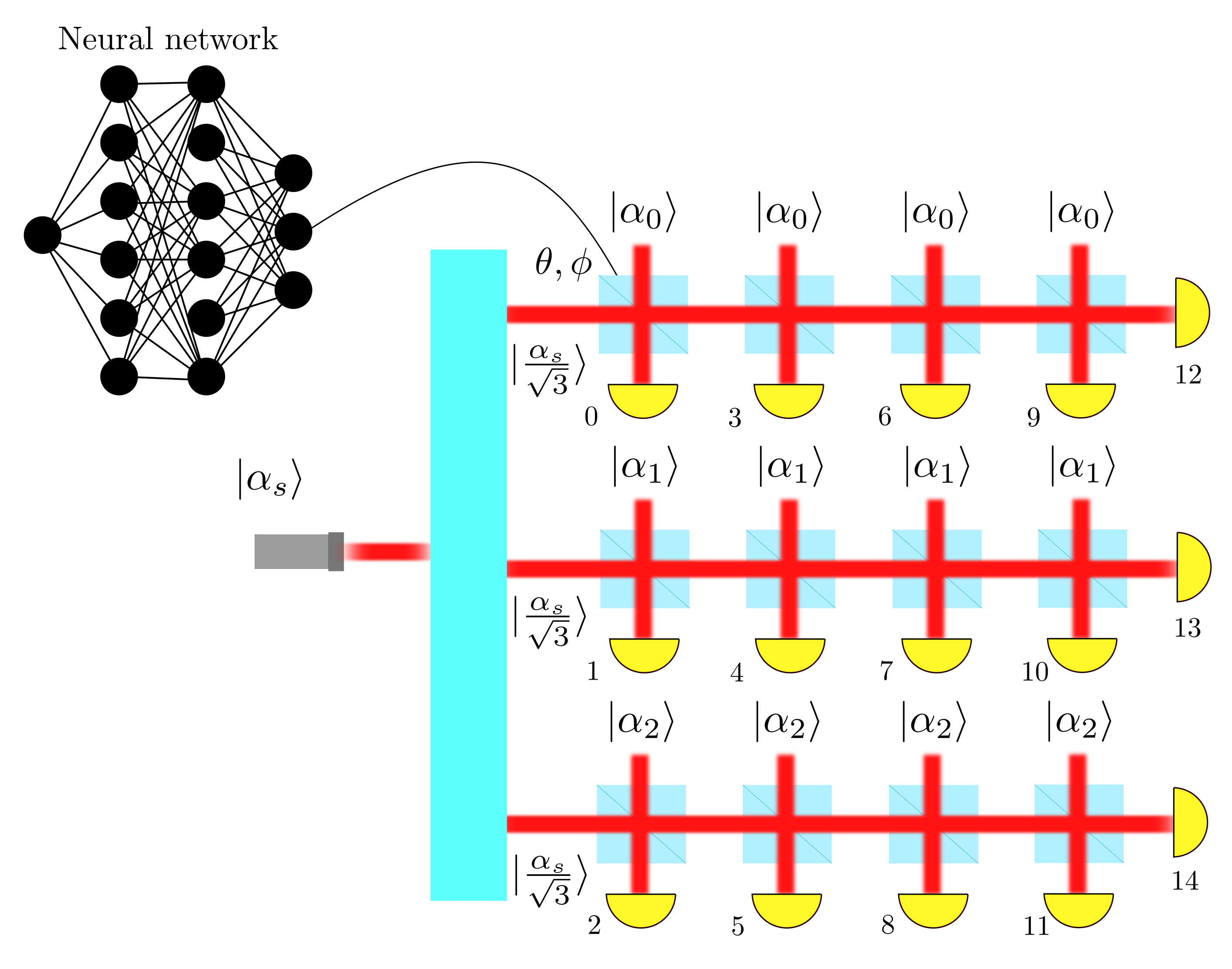
The original signal is first equally splitted on three wires, i.e.
. On each line the signal is mixed with the copies of the same training state.
The order of the measurements is show in the figure near the symbol for the photon counter. The measurements are not really done in parallel as it can be seen. All the outcomes of the previous photon counters contributes to the determination of the next controls through the particle filter and the neural network (or the decision tree). In order to realize the measurements in this order the optical path along the the wires should be prolonged differently.
Constructor of the
QMLDiscriminatorParallelclass.Parameters
- batchsize: int
Number of simultaneous estimations.
- params: List[
Parameter] Contains the real components of the unknown training states and the signal to be classified.
- num_ref: int
Number of training states for each class.
- resources: {“alpha”, “step”}
Type of resources counted.
- decision_tree: bool = False
Indicates that a decision tree is used for controlling the beam splitters.
- prec:
Floating point precision of the estimation.
- initialize_state(parameters: Tensor, num_systems: int) Tensor
Initializes the true state of the signal
for the parallel device.
Parameters
- parameters: Tensor
Tensor of shape (bs, num_system, 7) and type prec containing the real components of the three training states and the index classifying the true signal (the seventh parameter).
- num_systems: int
Size of the second dimension of the parameters Tensor. It is the number of systems treated per batch element.
Returns
- Tensor:
Tensor of shape (bs, num_system, 6) containing the state of the true signal, equally distributed on the three lines of the discrimination device with parallel architecture. If decision_tree=True the size of the last dimension of the returned Tensor is 7.
- model(outcomes: Tensor, controls: Tensor, parameters: Tensor, state: Tensor, meas_step: Tensor, num_systems: int = 1)
Probability of observing a certain number of photons in a photon counting measurement in the parallel device.
Parameters
- outcomes:
Tensor of shape (bs, num_systems, 1) and type prec containing the observed number of photons in a measurement.
- controls: Tensor
Tensor of shape (bs, num_systems, 2) and of type prec containing the two angles
and
characterizing the BS placed before a photon counter.
- parameters: Tensor
Tensor of shape (bs, num_systems, 7) and type prec containing the six real components of the three training states plus the signal class.
- state: Tensor
Tensor of shape (bs, num_systems, 6) containing the real components in the phase space of the signal traveling through the three wires of the apparatus. If decision_tree=True the shape of this Tensor is (bs, num_systems, 7) and it contains also the whole history of outcomes codified in the last entry.
- meas_step: Tensor
Tensor of shape (bs, num_systems, 1) and type prec. It is the index of the current measurement and starts from zero.
- num_systems: int = 1
Number of system treated for each element of the batch.
Return
- log_prob: Tensor
Tensor of shape (bs, num_systems) and type prec containing the logarithm of the probability of getting the observed number of photons.
- state: Tensor
Tensor of shape (bs, num_systems, 6) and type prec with the state of the signal evolved after the photon counting measurement. If decision_tree=True the shape of this Tensor is (bs, num_systems, 7) and it contains also the whole history of outcomes codified in the last entry.
- perform_measurement(controls: Tensor, parameters: Tensor, true_state: Tensor, meas_step: Tensor, rangen: Tensor)
Mixing of the signal on one wire with the corresponding training state and photon counting on one end of the beam splitter.
Parameters
- controls: Tensor
Tensor of shape (bs, 1, 2) and of type prec containing the two angles
and
characterizing the BS placed before a photon counter.
- parameters: Tensor
Tensor of shape (bs, 1, 7) and type prec containing the six real components of the three training states plus the signal class.
- true_state: Tensor
Tensor of shape (bs, 1, 6) containing the real components in the phase space of the signal traveling through the three wires of the apparatus. If decision_tree=True the shape of this Tensor is (bs, 1, 7) and it contains also the whole history of outcomes codified in the last entry.
- meas_step: Tensor
Tensor of shape (bs, 1, 1) and type prec. It is the index of the current measurement and starts from zero.
Return
- outcomes: Tensor
Tensor of shape (bs, 1, 1) and type prec containing the number of photons observed in the photon counting measurement.
- log_prob: Tensor
Tensor of shape (bs, 1) and type prec containing the logarithm of the probability of getting the observed number of photons.
- state: Tensor
Tensor of shape (bs, 1, 6) and type prec with the state of the signal evolved after the photon counting measurement. If decision_tree=True the shape of this Tensor is (bs, 1, 7) and it contains also the whole history of outcomes codified in the last entry.
- class QMLDiscriminatorSerial(batchsize: int, params: List[Parameter], num_ref: int, resources: str = 'alpha', prec: str = 'float64', decision_tree: bool = False)
Bases:
QMLDiscriminatorSerial strategy for classifying a coherent state, given three hypothesis.
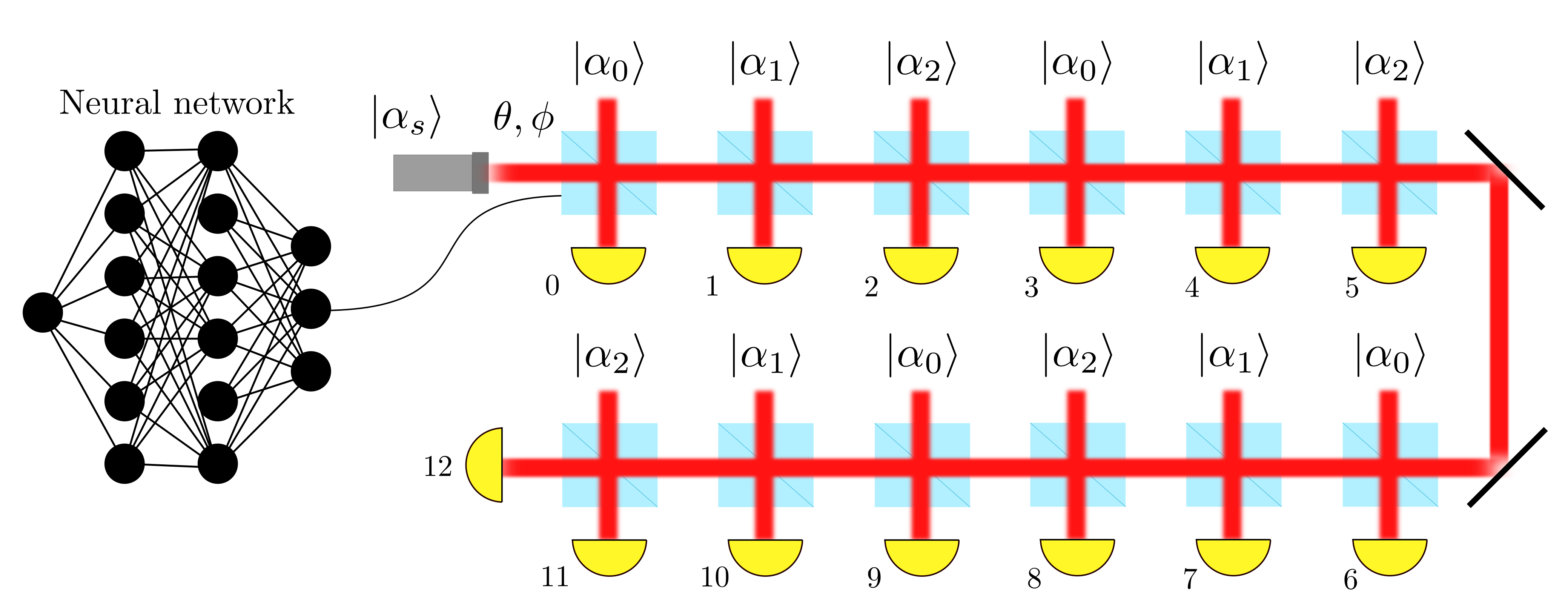
The signal
is alternatively mixed with the training states and measured.
The order of the measurements is shown in the figure near the symbols for the for the photon counters. All the outcomes of the previous photon counters contribute to the determination of the next controls through the particle filter and the neural network (or the decision tree)
Constructor of the
QMLDiscriminatorSerialclass.Parameters
- batchsize: int
Number of simultaneous estimations.
- params:
Real components of the unknown training states and signal to be classified.
- num_ref: int
Number of training states for each class.
- resources: {“alpha”, “step”}
Type of resources counted.
- prec:
Floating point precision of the estimation.
- initialize_state(parameters: Tensor, num_systems: int) Tensor
Initializes the true state of the signal
for the serial architecture.
Parameters
- parameters: Tensor[bs, num_systems, 7]
Tensor of shape (bs, num_system, 7) and type prec containing the real components of the three training states and the index classifying the true signal (the seventh parameter).
- num_systems: int
Size of the second dimension of the parameters tensor. It is the number of systems treated per batch element.
Returns
- Tensor:
Tensor of shape (bs, num_system, 2) containing the initial state of the signal
, computed according to parameters. If decision_tree=True the size of the last dimension of the returned Tensor is 3.
- model(outcomes: Tensor, controls: Tensor, parameters: Tensor, state: Tensor, meas_step: Tensor, num_systems: int = 1) Tuple[Tensor, Tensor]
Probability of observing a certain number of photons in a photon counting measurement in the serial device.
Parameters
- outcomes:
Tensor of shape (bs, num_systems, 1) and type prec containing the observed number of photons in a measurement.
- controls: Tensor
Tensor of shape (bs, num_systems, 2) and of type prec containing the two angles
and
characterizing the BS placed before a photon counter.
- parameters: Tensor
Tensor of shape (bs, num_systems, 7) and type prec containing the six real components of the three training states plus the signal class.
- state: Tensor
Tensor of shape (bs, num_systems, 2) containing the real components in the phase space of the signal traveling through the apparatus. If decision_tree=True the shape of this Tensor is (bs, num_systems, 3) and it contains also the whole history of outcomes codified in the last entry.
- meas_step: Tensor
Tensor of shape (bs, num_systems, 1) and type prec. It is the index of the current measurement and starts from zero.
- num_systems: int = 1
Number of system treated for each element of the batch.
Return
- log_prob: Tensor
Tensor of shape (bs, num_systems) and type prec containing the logarithm of the probability of getting the observed number of photons.
- state: Tensor
Tensor of shape (bs, num_systems, 2) and type prec with the state of the signal evolved after the photon counting measurement. If decision_tree=True the shape of this Tensor is (bs, num_systems, 3) and it contains also the whole history of outcomes codified in the last entry.
- perform_measurement(controls: Tensor, parameters: Tensor, true_state: Tensor, meas_step: Tensor, rangen: Tensor) Tuple[Tensor, Tensor, Tensor]
Mixing of the signal with the training state and photon counting on one end of the beam splitter.
Parameters
- controls: Tensor
Tensor of shape (bs, 1, 2) and of type prec containing the two angles
and
characterizing the BS placed before a photon counter.
- parameters: Tensor
Tensor of shape (bs, 1, 7) and type prec containing the six real components of the three training states plus the signal class.
- true_state: Tensor
Tensor of shape (bs, 1, 2) containing the real components in the phase space of the signal traveling through the apparatus. If decision_tree=True the shape of this Tensor is (bs, 1, 3) and it contains also the whole history of outcomes codified in the last entry.
- meas_step: Tensor
Tensor of shape (bs, 1, 1) and type prec. It is the index of the current measurement and starts from zero.
- rangen: Generator
Random number generator from the module
tensorflow.random.
Return
- outcomes: Tensor
Tensor of shape (bs, 1, 1) and type prec containing the number of photons observed in the photon counting measurement.
- log_prob: Tensor
Tensor of shape (bs, 1) and type prec containing the logarithm of the probability of getting the observed number of photons.
- state: Tensor
Tensor of shape (bs, 1, 2) and type prec containing the state of the signal evolved after the photon counting measurement. If decision_tree=True the shape of this Tensor is (bs, 1, 3) and it contains also the whole history of outcomes codified in the last entry.
- class QMLSimulation(particle_filter: ParticleFilter, phys_model: QMLDiscriminator, control_strategy: Callable, simpars: SimulationParameters, loss: int = 0)
Bases:
StatefulSimulationSimulation class for the QML classifier with three states.
Constructor of the
QMLSimulationclass.Parameters
- particle_filter:
ParticleFilter Particle filter responsible for the update of the Bayesian posterior on the parameters and on the state of the probe.
- phys_model:
DolinarThree Abstract description of the QML classifier.
- control_strategy: Callable
Callable object (normally a function or a lambda function) that computes the values of the controls for the next measurement from the Tensor input_strategy, which is produced by the method
generate_input().- simpars:
SimulationParameters Contains the flags and parameters that regulate the stopping condition of the measurement loop and modify the loss function used in the training.
- loss: {0, 1}
In principle the loss of the QML classifier is always the error probability of classifying the state wrongly. However there can be different classification strategies and accordingly different estimators for the error probability. In this class two possible loss functions are implemented. The details are reported in the documentation of the
loss_function()method.
- generate_input(weights: Tensor, particles: Tensor, state_ensemble: Tensor, meas_step: Tensor, used_resources: Tensor, rangen: Generator) Tensor
Generates the input to the control strategy (the neural network or the decision tree) starting from the particle filter ensemble.
The values chosen to be inputs of the neural network are similar to those provided in the example of the
dolinarmodule. These arethe average state of the signal after the photon counting measurements, computed from the posterior distribution. These can be 2 ore 6 scalar values according to the architecture of the apparatus,
, i.e. the average values of the real components of the training states computed from the posterior distribution,
, i.e. the standard deviation from the mean of the real components of the training states computed from the posterior distribution.
Given
one of these deviations, the value passed to the control strategy is actually
.
, i.e. the posterior probability for the initial state to be s=0, normalized in [-1, +1],
, i.e. the posterior probability for the initial state to be s=1, normalized in [-1, +1],
, i.e. the posterior probability for the initial state to be s=2, normalized in [-1, +1],
, i.e. the number of measurements normalized in [-1, +1].
is the total number measurement and corresponds to the attribute num_steps of
DolinarThree, while m is the index of the current photon counting measurement, i.e. meas_step,, this tells whether the current measure is performed by mixing the signal with
,
, or
.
For a serial architecture the number of scalar input is 19, while for a parallel one this number is 23.
Achtung! If decision_tree=True then input_tensor is composed of a single scalar value which encodes the string of outcomes already observed in the measurements.
- loss_function(weights: Tensor, particles: Tensor, true_state: Tensor, state_ensemble: Tensor, true_values: Tensor, used_resources: Tensor, meas_step: Tensor)
Returns the estimated error probability for each simulation in the batch. Two possible losses are implemented, and we can select which one to use in the simulation via the parameter loss of the
QMLSimulationclass constructor. Before defining these losses we need to introduce some notation.As in
generate_input()the posterior Bayesian probabilities of the signal being respectively s=0, 1, 2 are denominated,
, and
. We introduce the
-function, i.e.
(76)
and the guess function
:
(77)
The first possible loss, corresponding to loss=0, is
(78)
for which the idea is to try to push down the probabilities corresponding to the wrong hypothesis. This loss doesn’t operate on the guess
but directly on the posterior probabilities
.
The second loss, corresponding to loss=1, is
(79)
This loss is one if an error is made and zero if the guess is right. Averaged on many batches this loss converges to the error probability.
Both losses corresponds to an estimation strategy where the hypothesis with the highest posterior probability is always guessed.
- particle_filter:
- main()
We have trained the quantum Machine Learning classifier for both the parallel and the static architecture, for both losses, and two values of alpha_bound, i.e.
and
. We have observed the superiority of the serial architecture and of loss=1 in all the experiments carried out, and accordingly we report in the following only the performances of those simulations. All the estimations have been performed for num_ref=4. The resources are the mean number of photons in the apparatus, as described in the documentation of the
count_resources()method.We studied the performances of the discrimination device in the quantum regime, i.e. with a small number of photons, since for
the coherent states are perfectly distinguishable. With
the signal contains on average 0.5 photons, we should therefore expect relatively high discrimination errors even with optimal strategies. Nevertheless the point of the optimization is to extract every last bit of information from the device, even in a regime where the errors are relatively frequent.
This example is to be taken as less applicative then the others, instead, as a proof of principle of the potentials of the qsensoropt library.
The performances of the neural network and the decision tree are compared to that of the static strategy and to the pretty good measurement (PGM). This last cannot be realized with linear optics and photon counting and assumes a perfect a priori knowledge of the training states
,
, and
. To make a more fair comparison we assumed the PGM consumes 2 num_ref training states where the agnostic Dolinar consumes only num_ref. The extra copies are intended to be used to estimate the training states in order to later perform the corresponding PGM. Still the PGM error probability is not expected to be achievable.
The decision tree computes the next control based on the whole string of outcomes of the previous measurements. Given
, the outcome
of each measurement is classified into one of the three branches of the tree according to the conditions
,
, and
. The infinite possibilities for the outcomes (the number of observed photons) gets reduced to only three classes without too much loss of information.
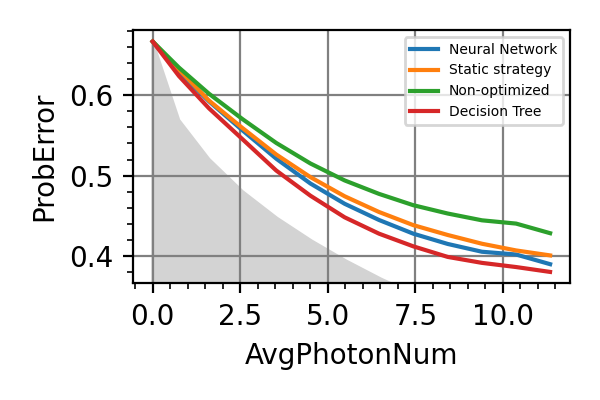
Fig. 39 alpha_bound=0.75, loss=1
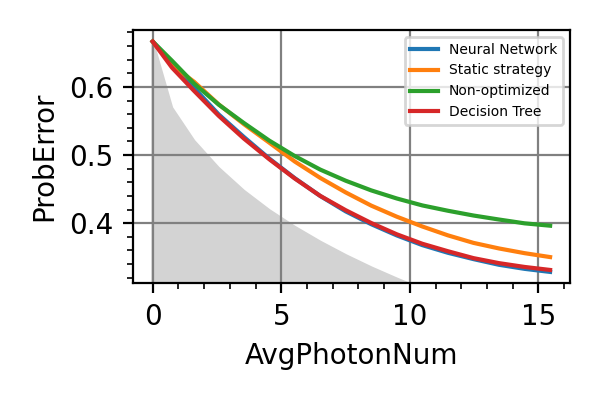
Fig. 40 alpha_bound=1.00, loss=1
The non-optimized strategy refers to a device where the phase imprinted by the beam-splitters are all zero and the reflectivity is chosen, so that the same fraction of the signal reaches each one of the photon counter.
There is an “adaptivity-gap” between the performances of the static controls and the two adaptive strategies (NN and decision tree). This gap starts from zero and grows with the average number of photons. This make sense, since with very few photons we don’t expect the adaptive measurements to be better than the static one, since almost always the measurement outcomes of the photon counters will be zero, which doesn’t give any information about the training states. On the other hand with many photons there is more space for learning. This can be also understood considering the number of possible trajectories of the particle filter ensemble during the estimation, which is one for
, and grows with the number of photons. More possible trajectories means having different controls on each one of them in order to improve the precision, which is by definition adaptivity.
In our experiments we observed that the convergence of the NN to the optimal strategy is slow and doesn’t always happen (see the case alpha_bound=0.75 in the figures), while the decision tree is shown to be a superior control for this device. In general, in a problem with many parameters and a relatively small space of possible outcome trajectories, the decision three is superior to the neural network. On the other hand with few parameters and a large space of outcome trajectories (like in the examples on NV centers) the decision three is unapplicable in the form we presented here and the NN is superior.
In the figure on the left the first nodes of the decision tree for alpha_bound=0.75 are shown. The controls from the decision tree have the advantage of being faster to compute with respect to those of the NN, but storing the tree requires more memory. A future work could be to trim the tree by keeping only the paths that correspond to the most probable trajectories (see the figure on the right).

alpha_bound=0.75, decision tree

trimmed decision tree
In the following figure five trajectories for the neural network controls
and
are showed. There is a tendency for the control trajectories to diverge in time (this can be seen well in the plot for
), since having already done some measurements means that the controls can be tailored to the particular instance of the task. This behaviour is trained in the neural network but is hard coded in the decision tree strategy.

Fig. 41 alpha_bound=1.00, loss=1
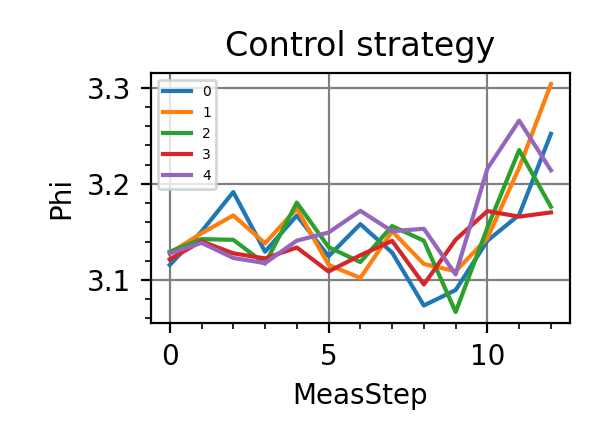
Fig. 42 alpha_bound=1.00, loss=1
The shaded grey areas in the above plot indicate the performances of the pretty good measurement, computed for multiple copies of the encoded states. This is not the ultimate precision bound regarding this discrimination problems, but it is a reasonable reference value not achievable with linear optics.
The fact the the training is able to find and exploit such small gain from the adaptivity speeks for the efficiency and power of the method.
Notes
For a large number of resources the error probability curves tend to saturate. This is because even with infinite num_ref and therefore perfect knowledge of the training states a single copy of the signal can’t be classified unambiguously.
For the estimation of seven parameter 512 particles in the ensamble are too few. Using 1024 particles improves the performances a bit, but not that much.
We mentioned that loss=1 always outperforms loss=0. This is because with loss=0 we assume that the error probability of the apparatus is the one estimated by the particle filter. In this way, however, the error probability is overeatimated.
In this example we are estimating multiple quantum incompatible parameters, that are the x and p components of the training states and the signal, whose corresponding generators don’t commute.
Known bugs: the training on the GPU freezes if the parameter alpha_bound is set to be too large. This is probably due to a bug in the implementation of the function random.poisson. A preliminary work-around has shown that reimplementing the extraction from a Poissonian distribution with random.categorical would solve the problem.
All the trainings of this module have been done on a GPU NVIDIA Tesla V100-SXM2-32GB or on a GPU NVIDIA GeForce RTX-4090-24GB, each requiring
hours.
- parse_args()
Arguments
- scratch_dir: str
Directory in which the intermediate models should be saved alongside the loss history.
- trained_models_dir: str = “./qml_classifier/trained_models”
Directory in which the finalized trained model should be saved.
- data_dir: str = “./qml_classifier/data”
Directory containing the csv files produced by the
performance_evaluation()and thestore_input_control()functions.- prec: str = “float64”
Floating point precision of the whole simulation.
- batchsize: int = 1024
Batchsize of the simulation.
- n: int = 64
Number of neurons per layer in the neural network.
- num_particles: int = 512
Number of particles in the ensemble representing the posterior.
- num_ref: int = 4
Number of copies of each training state
,
,
.
- iterations: int = 32768
Number of training steps.
- simulation_qmlclassifier(args, alpha_bound: float = 1.0, learning_rate: float = 0.01, loss: int = 0, arch: str = 'serial')
Simulation of the QML classifier.
Parameters
- args:
Arguments passed to the Python script.
- alpha_bound: float = 1.0
Size of the hypercube of the admissible values for the real components of the three training states.
- learning_rate: float = 1e-2
Initial learning rate for the neural network. The static strategy has a fixed initial learning rate of 1e-1. Both are reduced during the training according to
InverseSqrtDecay.- loss: {0, 1}
Type of loss for the training. The two possibilities (loss=0, 1) are discussed in the documentation of the
loss_function()method.- arch: {“serial”, “parallel”}
Architecture of device. If it is “serial” then an object
QMLDiscriminatorSerialis instantiated for the simulation, if it is “parallel” instead, an objectQMLDiscriminatorParallelis instantiated.
Photonic circuit
- class FourModesCircuit(batchsize: int, params: List[Parameter], prec: str = 'float64', single_control: bool = False, num_photons: int = 1)
Bases:
StatelessPhysicalModel,PhotonicCircuitFour modes interferometer for the simultaneous estimation of three phases 8.
The interferometer has two balanced quarter as opening and closing elements, which are the generalization of the balanced beam splitter for four modes in input and four modes in output. The three unknown phases are called
, while the control phases are
. See also the picture in the documentation of the
PhotonicCircuitSimulationclass.Constructor of the
FourModesCircuitclass.Parameters
- batchsize: int
Number of simultaneous estimations of the phases.
- params: List[
Parameter] List of parameters to be estimated, passed to the class constructor. These must be the three unknown phases in the interferometer, with their respective priors.
- prec: str = {“float64”, “float32”}
Floating point precision of the simulation.
- single_control: bool = False
If this flag is active, then the three control phases in the interferometer, i.e.
, are all equal to a single control phase
to be optimized, i.e.
.
- num_photons: {1, 2, 3, 4}
Mean number of photons in the input state to the interferometer, which is always a collection of coherent states
. This parameter can take integer values from 1 to 4 (extrema included), and the corresponding input states are
num_photons=1:
,
,
num_photons=2:
,
,
num_photons=3:
,
,
num_photons=4:
.
An average of one photon at most enters each line of the circuit.
Achtung!: The input states are not Fock states.
- count_resources(resources: Tensor, outcomes: Tensor, controls: Tensor, true_values: Tensor, meas_step: Tensor) Tensor
Each execution of the photonic circuit is counted as a consumed resource, and it is called a step.
- model(outcomes: Tensor, controls: Tensor, parameters: Tensor, meas_step: Tensor, num_systems: int = 1) Tensor
Returns the log-likelihood of getting a particular outcome for the photon counting measurements on each mode of the interferometer after the closing quarter.
Parameters
- outcomes: Tensor
Tensor of shape (bs, num_systems, 4) and type prec containing the number of photons to condition on for each of the four lines.
- controls: Tensor
If single_control=False this is a Tensor of shape (bs, num_systems, 3) and of type prec containing the three control phases, while if single_control=True this Tensor has shape (bs, num_systems, 1) and contains the single control phase.
- parameters: Tensor
Tensor of shape (bs, num_systems, 3) and type prec containing the ensemble particles for the three unknown phases.
- meas_step: Tensor
Tensor of shape (bs, num_systems, 1) and type prec. It is the index of the current execution of the interferometer and starts from zero. We call a single circuit execution, i.e. sending the input and measuring the outcome, a step.
- num_systems: int = 1
Number of circuits simulated for each batch element.
Returns
- prob: Tensor
Tensor of shape (bs, num_systems) and type prec containing the probability of getting outcomes as a results upon the execution of the photon counting measurement.
- perform_measurement(controls: Tensor, parameters: Tensor, meas_step: Tensor, rangen: Generator) Tuple[Tensor, Tensor]
The input state of the four bosonic modes is fed to the circuit and a photon counting measurement is performed on each output lines after the closing quarter.
Parameters
- controls: Tensor
If single_control=False this is a Tensor of shape (bs, 1, 3) and of type prec containing the three control phases, while if single_control=True this Tensor has shape (bs, 1, 1) and contains the single control phase.
- parameters: Tensor
Tensor of shape (bs, 1, 3) and type prec containing the true values of the three phases to be estimated
.
- meas_step: Tensor
Tensor of shape (bs, 1, 1) and type prec. It is the index of the current execution of the interferometer and starts from zero. We call a single circuit execution, i.e. sending the input and measuring the outcome, a step.
- rangen: Generator
Random number generator from the module
tensorflow.random.
Returns
- outcomes: Tensor
Tensor of shape (bs, 1, 4) and type prec containing the number of photons observed in the photon counting measurement on each of the four lines.
- log_prob: Tensor
Tensor of shape (bs, 1) and type prec containing the logarithm of the probability of getting the observed number of photons.
- class PhotonicCircuit(batchsize: int, num_wires: int, prec: str = 'float64')
Bases:
CoherentStatesProgrammable multimode photonic circuit. Non-linear elements (other than photon counting) can’t be implemented. No homodyne measurement is available.
Constructor of the
PhotonicCircuitclass.Parameters
- batchsize: int
Number of simultaneous simulations of the circuit.
- num_wires: int
Number of bosonic lines in the circuit.
- prec: {“float64”, “float32”}
Floating point precision of the simulation.
- balanced_beamsplitter_line(state: Tensor, i: int, num_systems: int) Tensor
Applies a balanced beamsplitter without phase shift between two consecutive bosonic lines.
Parameters
- state: Tensor
Tensor of shape (bs, num_systems, 2 num_wires) of type prec containing the real components of the state of the num_wires bosonic modes. The x-components are the entries from 0 to num_wires-1, and the p-components the entries from num_wires to 2 num_wires-1.
- i: int
The balanced BS is applied between the i-th and the i+1-th line. The counting starts from zero.
- num_systems: int
Size of the second dimension of state. It is the number of circuits simulated for each element of the batch, i.e. for each estimation.
Returns
- state: Tensor
Tensor of shape (bs, num_systems, 2 num_wires) of type prec containing the evolved state of the photonic circuit after the application of the beamsplitter.
- beamsplitter_line(state: Tensor, theta: Tensor, phi: Tensor, i: int) Tensor
Controllable beamsplitter between two consecutive lines.
The symbol ? in the shape of a Tensor means that this dimension can have arbitrary size unknown to this method.
Parameters
- state: Tensor
Tensor of shape (bs, ?, 2 num_wires) of type prec containing the real components of the state of the num_wires bosonic modes. The x-components are the entries from 0 to num_wires-1, and the p-components the entries from num_wires to 2 num_wires-1.
- theta: Tensor
Tensor of shape (bs, ?) and of type prec. It contains the transmission coefficient of the BS. It is indicated with
.
- phi:
Tensor of shape (bs, ?) and of type prec. It contains the phase applied by the BS. It is indicated with
.
- i: int
The BS is applied between the i-th and the i+1-th line. The counting starts from zero.
Returns
- state: Tensor
Tensor of shape (bs, ?, 2 num_wires) of type prec containing the evolved state of the photonic circuit after the application of the beamsplitter.
- phase_shift_line(state: Tensor, phase: Tensor, i: int) Tensor
Controllable phase shift on the i-th bosonic mode.
The symbol ? in the shape of a Tensor means that this dimension can have arbitrary size unknown to this method.
Parameters
- state: Tensor
Tensor of shape (bs, ?, 2 num_wires) of type prec containing the real components of the state of the num_wires bosonic modes. The x-components are the entries from 0 to num_wires-1, and the p-components the entries from num_wires to 2 num_wires-1.
- phase: Tensor
Tensor of shape (bs, ?) and type prec containing the phase shift to be applied to the i-th bosonic mode.
- i: int
Index of the bosonic mode to be phase shifted. The counting starts from zero.
Returns
- state: Tensor
Tensor of shape (bs, ?, 2 num_wires) of type prec containing the evolved state of the photonic circuit.
- photon_counting_all(state: Tensor, rangen: Generator) Tuple[Tensor, Tensor]
Performs the photon counting on each line of the circuit individually.
Parameters
- state: Tensor
Tensor of shape (bs, 1, 2 num_wires) of type prec containing the real components of the state of the num_wires bosonic modes. The x-components are the entries from 0 to num_wires-1, and the p-components the entries from num_wires to 2 num_wires-1.
- rangen: Generator
Random number generator from the module
tensorflow.random.
Returns
- outcomes: Tensor
Number of photons observed on each line. It is a Tensor of shape (bs, 1, num_wires) and type prec.
- log_prob: Tensor
Log-likelihood of getting the observed outcomes upon the measurement. It is a Tensor of shape (bs, 1) and type prec.
- postselect_photon_counting_all(state: Tensor, outcomes: Tensor, num_systems: int = 1) Tensor
Postselection of the photon counting result on each line of the photonic circuit.
Parameters
- state: Tensor
Tensor of shape (bs, num_systems, 2 num_wires) of type prec containing the real components of the state of the num_wires bosonic modes. The x-components are the entries from 0 to num_wires-1, and the p-components the entries from num_wires to 2 num_wires-1.
- outcomes: Tensor
Tensor of shape (bs, num_systems, num_wires) and type prec containing the number of photons in each line to condition on.
- num_systems: int
Size of the second dimension of state. It is the number of circuits simulated for each element of the batch, i.e. for each estimation.
Returns
- log_prob: Tensor
Log-likelihood of getting outcomes as result upon the photon counting measurements. It is a Tensor of shape (bs, num_systems) and type prec.
- total_mean_phot(state: Tensor, num_systems: int) Tensor
Computes the total mean photon number in the photonic circuit.
Given a list of states
for the
bosonic line, this method returns
(80)
Parameters
- state: Tensor
Tensor of shape (bs, num_systems, 2 num_wires) of type prec containing the real components of the state of the num_wires bosonic modes. The x-components are the entries from 0 to num_wires-1, and the p-components the entries from num_wires to 2 num_wires-1.
- num_systems: int
Size of the second dimension of state. It is the number of circuits simulated for each element of the batch, i.e. for each estimation.
Returns
- Tensor:
Mean number of photons present in the entire circuit. It is a Tensor of shape (bs, num_systems) and type prec.
- class PhotonicCircuitSimulation(particle_filter: ParticleFilter, phys_model: FourModesCircuit, control_strategy: Callable, simpars: SimulationParameters, random: bool = False)
Bases:
StatelessMetrologySimulation for the
FourModesCircuitclass.Achtung! This
Simulationclass is implemented for unknown phases that are defined as discrete parameters, that is, that can take values only in a finite set. For this reason the task solved here is hypothesis testing.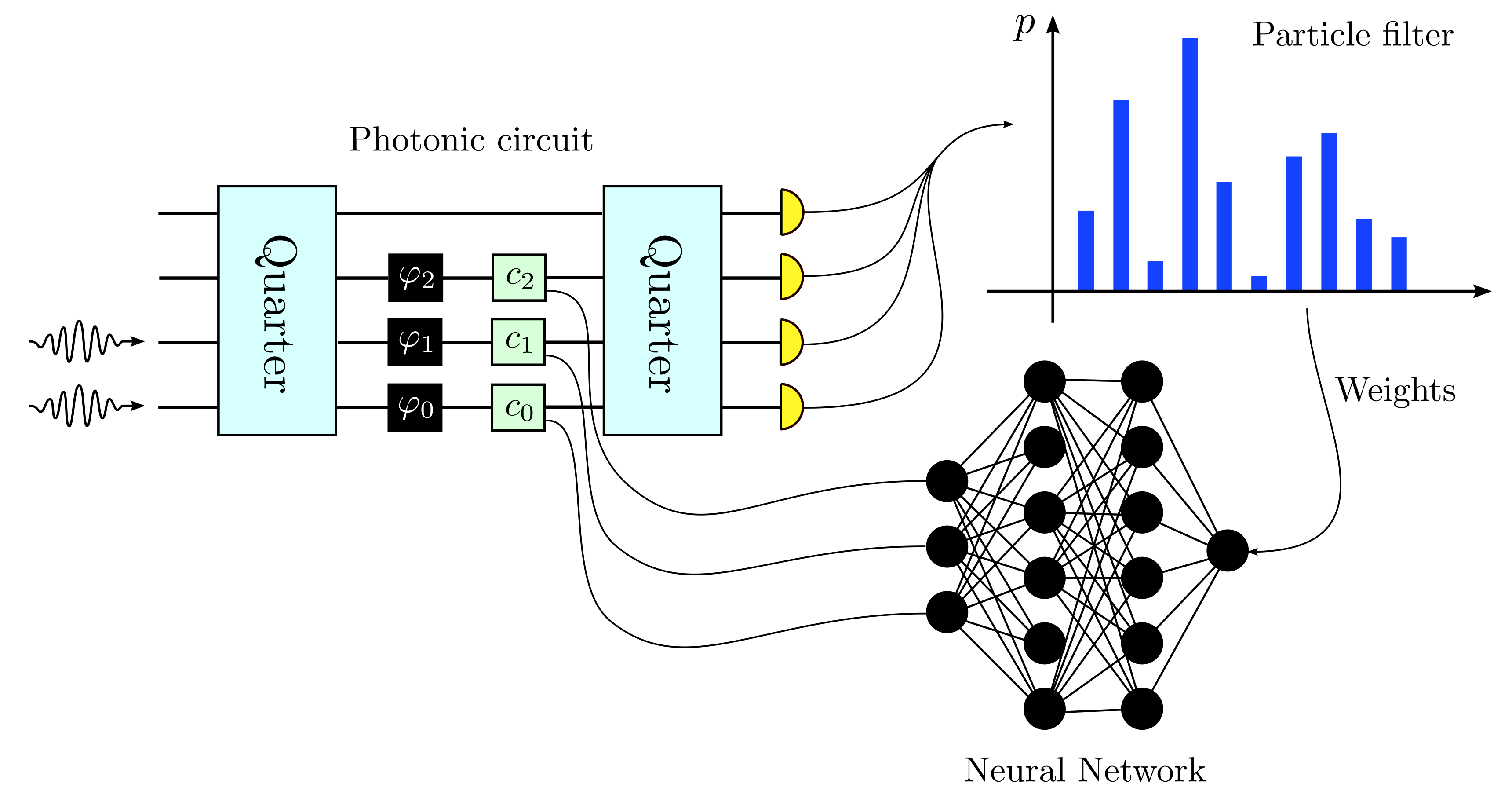
Given the number of possible values
that each phase can assume, i.e. the length of the values attributes of their respective
Parameterobjects, the total number of hypothesis to discriminate is. The particle filter contains one and only one particle for each hypothesis along with their corresponding weights
, that are updated with the Bayes rule after each step.
The posterior distribution on the hypothesis is the input to the control strategy. The loss function
loss_function()simply returns the probability of guessing the wrong hypothesis after all the measurements.Constructor of the
PhotonicCircuitSimulationclass.Parameters
- particle_filter:
ParticleFilter Particle filter responsible for the update of the Bayesian posterior on the hypothesis.
- phys_model:
FourModesCircuit Abstract description of the balanced four mode interferometer.
- control_strategy: Callable
Callable object (normally a function or a lambda function) that computes the values of the controls
for the next step.
- simpars:
SimulationParameters Contains the flags and parameters that regulate the stopping condition of the measurement loop and modify the loss function used in the training.
- random: bool = False
If this flag is True a column of random numbers extracted uniformly in
is appended to the input_tensor generated by
generate_input()for each control in the circuit. The number of controls can be either three or one according to the flag single_control of phys_model.
- generate_input(weights: Tensor, particles: Tensor, meas_step: Tensor, used_resources: Tensor, rangen: Generator) Tensor
Generates the input_tensor passed to control_strategy, on the basis which the next controls are predicted.
The input_tensor is composed on the following columns:
weights, i.e. the posterior distribution on the possible values of the phases. These are
columns,
meas_step normalized in [-1, +1],
used_resources normalized in [-1, +1].
one or three columns of random numbers uniformly extracted in
. This is present only if random=True.
The shape of the returned input is (bs, input_size), with input_size being
if random=False or
if random=True and single_control=False.
- loss_function(weights: Tensor, particles: Tensor, true_values: Tensor, used_resources: Tensor, meas_step: Tensor) Tensor
Loss function for the hypothesis testing in the four arms interferometer.
On each estimation in the batch the loss is zero if the correct phases are guessed correctly and one if they are guessed wrongly. In symbols, given the delta function
(81)
the guess based on the Bayesian posterior is
(82)
and calling
the index of the correct hypothesis for the phases values the loss can be expressed as
(83)
which, averaged on the batch is the error probability.
- particle_filter:
- main()
In the following we report the evaluated error probability in the correct identification of three phases in a four arms interferometer with various input states. Each phase can assume the two values
. The three phases
can be controlled, see the picture in the documentation of the
PhotonicCircuitSimulationclass, and the performances of three control strategies have been compared for the same input states.With this circuit we are testing in parallel for each slot whether a phase shift is there or not. This phase shift could be due to the presence of a certain object, a chemical species, or it could be a piece of codified information.
The following plots represent the probability of guessing the unknown phases wrong as a function of the mean number of photons consumed in the estimation and of the number of measurements, for the adaptive, the static, and the random strategies.
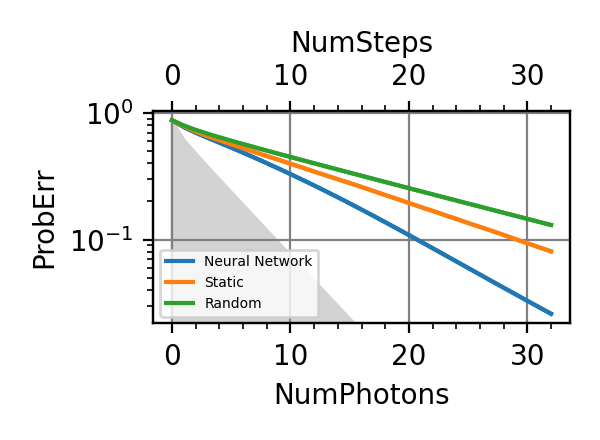
Fig. 43 num_photons=1
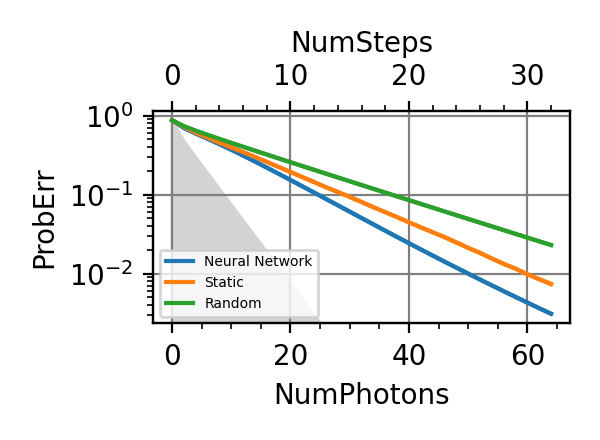
Fig. 44 num_photons=2
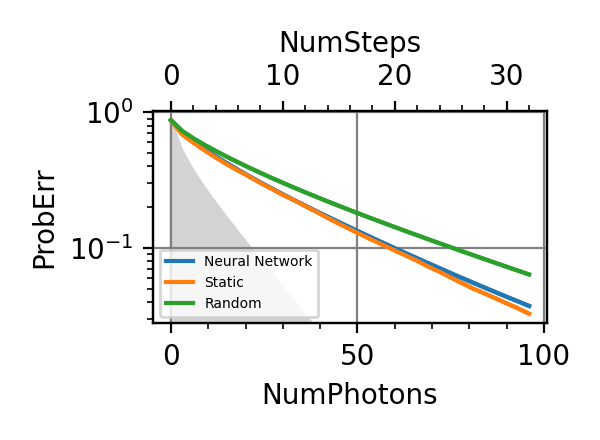
Fig. 45 num_photons=3

Fig. 46 num_photons=4
The shaded grey areas in the above plot indicate the performances of the pretty good measurement, computed for multiple copies of the encoded states. This is not the ultimate precision bound regarding this discrimination problems, but it is a reasonable reference value not achievable with linear optics.
Only for num_photons=1, 2 the adaptive strategy has been proven to give some advantage with respect to the static one. The state with three photons doesn’t perform well in comparison to all the other inputs. The best input in terms of the consumed number of photons to reach a certain probability error is the state with a single photon on average. It is possible that in terms of the damage caused to the sample or the energy used (which are both proportional to the total number of photons) performing many measures each with a vanishingly small photon number is optimal. This hypothesis should be verified with more simulations in the range num_photons<1. If it that is the case, then minimizing the energy or the damage would mean stretching the total measurement time, which could also be unfeasible beyond a certain amount. For a fixed number of measurements, therefore for a fixed estimation time, the states with many photons seem to perform better then those with less photons (num_photons=3 being an exception). The fact that for different resources either the states with many of with few photons are optimal underlines the importance of clearly identifying the resource when discussing metrology. Other simulations should be performed for the input states
,
and
to asses their usefulness.
Notes
Known bugs: the training on the GPU freezes if the number of input photons is too large. This is probably due to a bug in the implementation of the function random.poisson. A preliminary work-around has shown that reimplementing the extraction from a Poissonian distribution with random.categorical would solve the problem.
All the training of this module have been done on a GPU NVIDIA Tesla V100-SXM2-32GB, each requiring
hours.
- parse_args()
Arguments
- scratch_dir: str
Directory in which the intermediate models should be saved alongside the loss history.
- trained_models_dir: str = “./photonic_circuit/trained_models”
Directory in which the finalized trained model should be saved.
- data_dir: str = “./photonic_circuit/data”
Directory containing the csv files produced by the
performance_evaluation()and thestore_input_control()functions.- prec: str = “float64”
Floating point precision of the whole simulation.
- batchsize: int = 4096
Batchsize of the simulation.
- n: int = 64
Number of neurons per layer in the neural network.
- num_steps: int = 32
Number of uses of the interferometer, i.e. number of measurements in the hypothesis testing.
- iterations: int = 32768
Number of training steps.
- photonic_circuit_estimation(args, learning_rate: float = 0.01, gradient_accumulation: int = 1, cumulative_loss: bool = True, phase_values: Tuple = (0, 1), single_control: bool = False, num_photons: int = 1)
Simultaneous estimation of three phases in the four arms interferometer as describe by the
FourModesCircuitclass.Each call to this function will perform the hypothesis testing on the values of the three phases for three strategies, i.e. the adaptive one implemented with a NN, the static, and the random strategies.
Parameters
- args:
Arguments passed to the Python script.
- learning_rate: float = 1e-2
Initial learning rate for the neural network. The static strategy has a fixed initial learning rate of 1e-1. Both are reduced during the training according to
InverseSqrtDecay.- gradient_accumulation: int = 1
Flag of the
train()function.- cumulative_loss: bool = True
Flag
cumulative_loss. Set for all the simulations.- phase_values: Tuple = (0, 1)
Contains the possible discrete values that each phase
can assume independently.
- single_controls: bool = False
If the function is called with single_control=True, then it will evaluate the performances of the adaptive, random, and static strategies in the scenario where the three controllable phases are all equal, i.e.
, and there is therefore only a single scalar control
. This flag is used in the initialization of the
FourModesCircuitobject.- num_photons: int = 1
Mean number of photons in the input state of the interferometer for each measurement step. This values is used in the initialization of the
FourModesCircuitobject.
Linear Multiclassifier
- class ClassifierSimulation(particle_filter: ParticleFilter, phys_model: LinearMulticlassifier, control_strategy: Callable, simpars: SimulationParameters, random: bool = False)
Bases:
StatelessSimulationSimulation class associated to the
LinearMulticlassifierphysical model.Attributes
- bs: int
Batchsize of the simulation.
- phys_model:
LinearMulticlassifier Parameter phys_model passed to the class constructor.
- control_strategy: Callable
Parameter control_strategy passed to the class constructor.
- pf:
ParticleFilter Parameter particle_filter passed to the class constructor.
- input_size: int
This attribute depends on the flag random. If random=False then input_size=1 while if random=True then input_size=2 phys_model.num_wires^2.
- input_name: List[str]
If random=False then this list contains only the string “MeasStepOverMaxStep”, while if random=True then it contains the name of all the BS network parameters, i.e.
and
for
and
- simpars:
SimulationParameters Parameter simpars passed to the class constructor.
- num_layers: int
Number of BS layers in the signal estimation. It is the
num_stepsattribute of simpars. It is indicated also within the formulas.
- random: bool = False
Flag random passed to the class constructor.
Constructor of the
ClassifierSimulationclass.Parameters
- particle_filter:
ParticleFilter Particle filter responsible for the update of the Bayesian posterior on the hypothesis.
- phys_model:
LinearMulticlassifier Abstract description of the linear multiclassifier.
- control_strategy: Callable
Callable object (normally a function or a lambda function) that computes the values of the controls for the next measurement from the Tensor input_strategy. If random=False then input_strategy contains only the (renormalized) index of the current layer and the control_strategy should return the corresponding BS parameters to be optimized. If on the other hand random=True input_strategy contains a randomly extracted parametrization of a BS network, that control_strategy can immediately return.
- simpars:
SimulationParameters Contains the flags and parameters that regulate the stopping condition of the measurement loop and modify the loss function used in the training.
- random: bool = False
If this flag is True the 2 phys_model.num_wires^2 randomized controls for the BS network are added to the output of the
generate_input()method.
- generate_input(weights: Tensor, particles: Tensor, meas_step: Tensor, used_resources: Tensor, rangen) Tensor
Builds the input_strategy tensor.
If random=False this method returns
, where
is meas_step, i.e. the index of the current layer and
is the total number of layers, i.e. the attribute num_layers. This is a Tensor of shape (bs, 1) and type prec
If, on the other hand, random=True this method returns
randomly extracted angles in
, which identify a BS network. This is a Tensor of shape (bs, 2 phys_model.num_wires^2) and type prec.
- loss_function(weights: Tensor, particles: Tensor, true_values: Tensor, used_resources: Tensor, meas_step: Tensor) Tensor
After all the measurements have been performed the particle filter contains a discrete distribution of posterior probabilities for the signal classes, i.e.
. The guess for the signal class is defined by the function
(84)
and the loss is
(85)
with
(86)
Averaged on many batch
approximates the error probability.
- class LinearMulticlassifier(batchsize: int, list_alphas: Tuple[complex], prec: str = 'float64')
Bases:
StatelessPhysicalModel,PhotonicCircuitModel for a network of beam splitters (BS) and phase shifts that receives as input the signal
to be classified, with
being the classes. The number
is the attribute num_hypothesis and the length of the tuple list_alphas passed to the constructor.

The other inputs of the network are in order
,
,
, …,
, that is, the reference states corresponding to the possible hypothesis (classes), which, at difference with the example of the
dolinar_threeare fixed for each execution of the task. It follows that the network haswires. The output of the network is measured with individual photon counters on each wire.
The signal
will be classified according to the photon counters outcomes. If more than one signal state is available multiple BS networks can be stacked on one another and the classification will be based on the measurements on all the layers. Each layer can have a different network BS0, BS1, …
Attributes
- bs: int
Batchsize of the simulation.
- list_alphas: Tuple[complex]
List of reference states. It is a parameter passed to the class constructor.
- num_hypothesis: int
Number of classes or hypothesis. It is the length of the tuple list_alphas. It is also indicated with the symbol
.
- num_wires: int
Number of wires in the network. It is num_hypothesis+1, i.e.
.
- controls: List[
Control] Real parameters identifying the BS network.
- params: List[
Parameter] Contains the description of the unknown to be estimated, i.e. the discrete parameter Signal that takes values in the set
. The initial value randomization must be disabled in this application, i.e. the flag randomize of the
Parameterconstructor must be set to False. In this way initializingparticle in the
ParticleFilterwill produce particles with valuesin this order and without repetitions.
- controls_size: int
Number of real parameters of the BS network, i.e.
.
- d: int = 1
Number of unknown parameters to estimate, i.e. one, the signals class.
- outcomes_size: int
Number of scalar outcomes for each layer of networks, i.e. the number of wires
.
- prec: str
Floating point precision of the controls, outcomes, and parameters.
Constructor of the
LinearMulticlassifierclass.Parameters
- batchsize: int
Number of simultaneous estimations.
- list_alphas: Tuple[complex]
Tuple of complex numbers
that represent the reference states.
- prec: = {“float64”, “float32”}
Floating point precision of the controls, outcomes, and parameters.
- count_resources(resources: Tensor, outcomes: Tensor, controls: Tensor, true_values: Tensor, meas_step: Tensor) Tensor
The execution of each BS layer is counted as a consumed resource.
- model(outcomes: Tensor, controls: Tensor, parameters: Tensor, meas_step: Tensor, num_systems: int = 1) Tensor
Returns the probability of getting a certain number of photons after the application of the BS network to the input state
.
Parameters
- outcomes: Tensor
Tensor of shape (bs, num_systems, num_wires) and type prec containing the number of photons measured on each wire of the system after the application of the network.
- controls: Tensor
Tensor of shape (bs, num_systems, 2 num_wires^2) and type prec that parametrizes the BS network.
- parameters: Tensor
Tensor of shape (bs, num_systems, 1) and type prec that contains the class s of the signal
for each particle in the particle filter ensemble.
- meas_step: Tensor
Tensor of shape (bs, num_systems, 1) and type int32 that contains the index of the current BS layer. It starts from zero.
- num_systems: int = 1
Number of BS networks processed per batch.
Returns
- prob: Tensor
Tensor of shape (bs, num_systems) of type prec containing the probabilities of getting the number of photons outcomes after the BS network defined by controls has been applied on the signal defined by parameters.
- perform_measurement(controls: Tensor, parameters: Tensor, meas_step: Tensor, rangen: Generator) Tuple[Tensor, Tensor]
Application of the BS network to the input state
and subsequent photon counting measurements on all the wires.
Parameters
- controls: Tensor
Tensor of shape (bs, 1, 2 num_wires^2) and type prec that parametrizes the BS network.
- parameters: Tensor
Tensor of shape (bs, 1, 1) and type prec that contains the class s of the signal
for each element of the batch.
- meas_step: Tensor
Tensor of shape (bs, 1, 1) and type int32 that contains the index of the current BS layer. It starts from zero.
- rangen: Generator
Random number generator from the module
tensorflow.random.
Returns
- outcomes: Tensor
Tensor of shape (bs, 1, num_wires) and type prec containing the number of photons measured on each wire of the system after the application of the BS network.
- log_prob: Tensor
Tensor of shape (bs, 1) and type prec containing the logarithm of the probability of getting the observed number of photons (the likelihood).
- bs_network_classify(args, batchsize: int, list_alphas: Tuple[complex], learning_rate: float = 0.1)
Runs the training of the linear multiclassifier for the list of reference states list_alphas. Compares the performances of the trained BS networks with that of randomly extracted networks.
Parameters
- args:
Arguments passed to the Python script.
- batchsize: int
Number of simultaneous classifications.
- list_alphas: Tuple[complex]
Tuple of complex numbers
that represent the reference states.
- learning_rate: float = 1e-1
Initial learning rate for the training of the BS network. The learning rate is reduced during the training according to
InverseSqrtDecay.
Notes
Known bugs: the training on the GPU freezes if the number of photons in the apparatus is too large. This is probably due to a bug in the implementation of the function random.poisson. A preliminary work-around has shown that reimplementing the extraction from a Poissonian distribution with random.categorical would solve the problem.
At difference with other examples we haven’t used a neural network here, and therefore we don’t have adaptivity.
All the training of this module have been done on a GPU NVIDIA Tesla V100-SXM2-32GB, each requiring
hours.
- main()
The linear multiclassifier has been trained and tested for some symmetric configurations of the
. In particular the roots of the unit for
have been chosen. For a symmetric configuration of states the pretty good measurement (PGM) is optimal, but it can’t be achieved with linear optics. The optimality of the PGM means that a single layer BS network can’t achieve the performances of the PGM, however this raises the interesting question of how many layers (and copies of the signal
) are necessary to match or surpass the error probability of the PGM. Beside that, the performances of the trained BS networks are also compared to that of randomly extracted networks.
The following plots represent the error probability in the classification of the signal versus the number of layers of the linear multiclassifier (a single “resources” is the execution of a layer).

Fig. 47 m=3
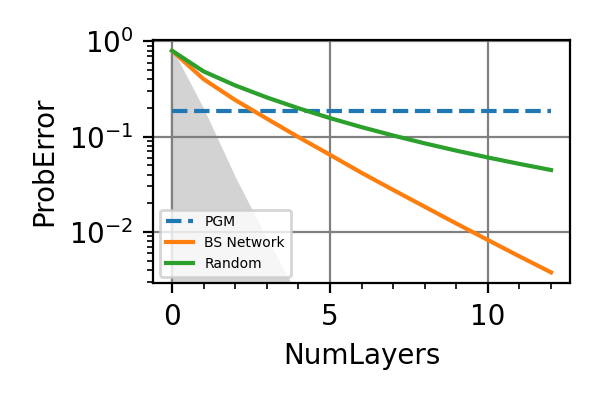
Fig. 48 m=5
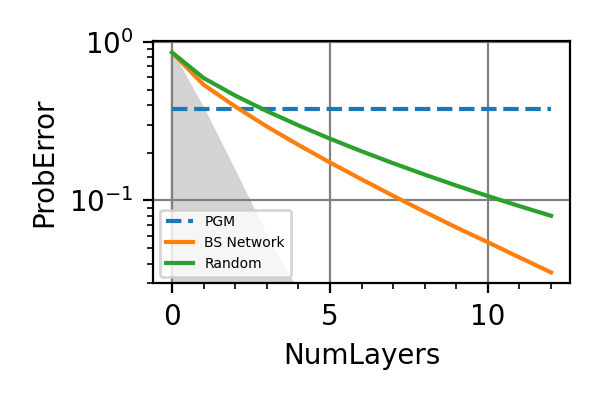
Fig. 49 m=7
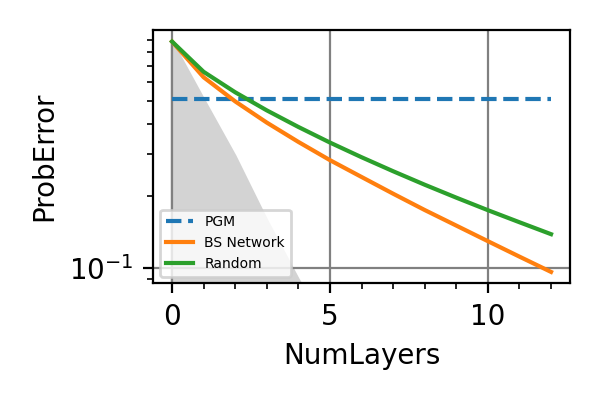
Fig. 50 m=9
The shaded grey areas in the above plot indicate the error probability of the PGM for many copies of the signal.
Three copies of the signal are always sufficient in these examples to match the PGM error probability. An interesting observation is that the advantage over the random strategy that the trained network has, decreases as the number of hypothesis grows. For
we expect to have no gain. An adaptive strategy may be able to restore the gap with the untrained BS networks.
This example has been suggested to us by L. Bagnasacco.
Notes
In this example we are estimating two quantum incompatible parameters, that are the x and p components of the signal state, whose corresponding generators don’t commute.
All the training of this module have been done on a GPU NVIDIA Tesla V100-SXM2-32GB, each requiring
hours.
- parse_args()
Arguments
- scratch_dir: str
Directory in which the intermediate models should be saved alongside the loss history.
- trained_models_dir: str = “./linear_multiclassifier/trained_models”
Directory in which the finalized trained model should be saved.
- data_dir: str = “./linear_multiclassifier/data”
Directory containing the csv files produced by the
performance_evaluation()and thestore_input_control()functions.- prec: str = “float64”
Floating point precision of the whole simulation.
- batchsize: int = 8192
Batchsize of the simulation.
- num_layers: int = 12
Maximum number of layers of BS network.
- iterations: int = 4096
Number of training steps.
Optical Cavity
- class CavityParameters(delta_time: float, kappa: float, chi: float, num_photons: float, init_displacement: float, omega: float)
Bases:
objectPhysical parameters of the optical cavity.
- chi: float
Squeezing parameter of the non-linear crystal inside the cavity.
- delta_time: float
Time between two consecutive homodyne detections.
- init_displacement: float
Magnitude of the initial displacement of the cavity state in the phase space along the direction (1, 1).
- kappa: float
Fraction of the signal extracted at each homodyne measurement per second.
- num_photons: float
Thermal noise in the initial state of the cavity, i.e. number of photons in the thermal state.
- omega: float
Detuning between the cavity and the driving laser frequencies. It is the parameter to be sensed.
- class OpticalCavity(batchsize: int, params: List[Parameter], cav_parameters: CavityParameters, prec: str = 'float64')
Bases:
StatefulPhysicalModelAbstract model for an optical cavity with a single mode, that can be measured via homodyne detection.
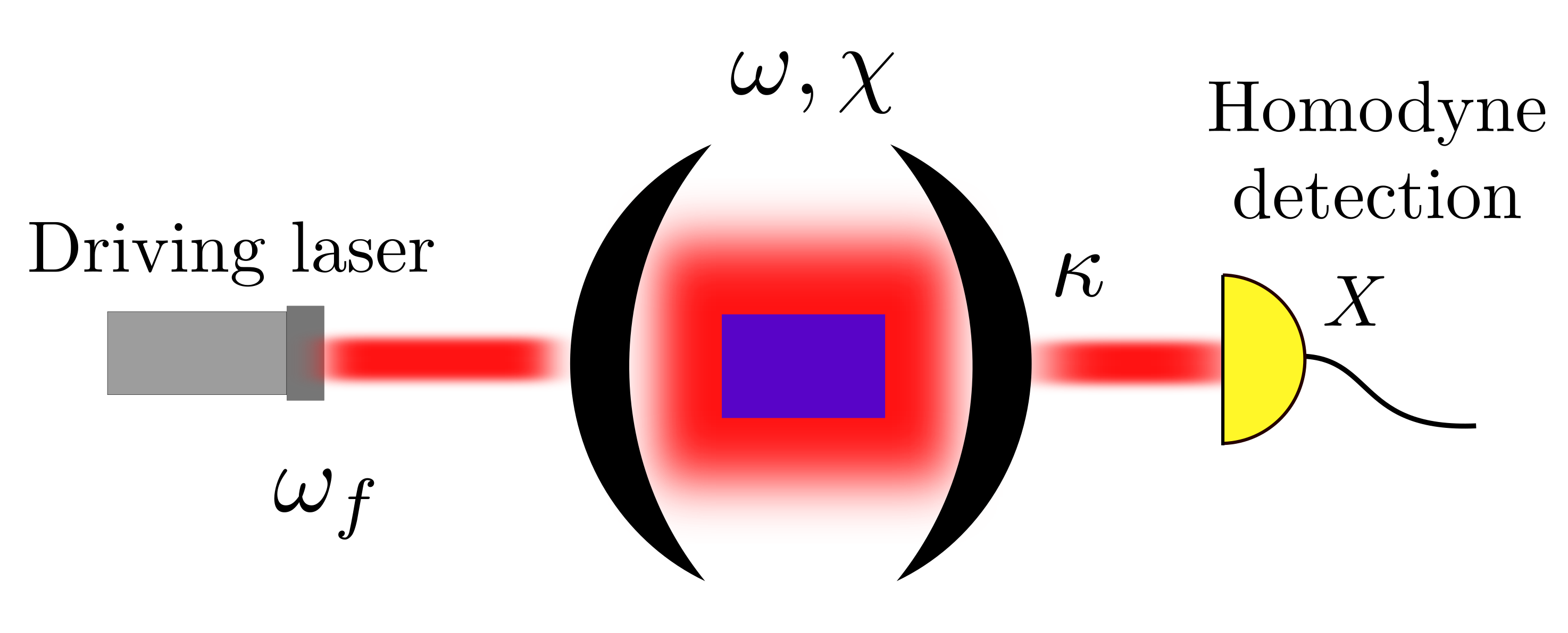
This model is taken from the paper of Fallani et al. 9.
- 9
A. Fallani, M. A. C. Rossi, D. Tamascelli, and M. G. Genoni, PRX Quantum 3, 020310 (2022).
Constructor of the
OpticalCavityclass.Parameters
- batchsize: int
Number of simultaneous estimations of the detuning frequency.
- params: List[
Parameter] List of unknown parameters to be estimated in the optical cavity experiment. It should contain the parameter Omega, i.e. the detuning frequency, with a single possible admissible value, that is the point at which the sensing is performed.
- cav_parameters:
CavityParameters Contains the values of the physical parameters of the cavity.
- prec: {“float64”, “float32”}
Floating point precision of the estimation.
- count_resources(resources: Tensor, outcomes: Tensor, controls: Tensor, true_values: Tensor, state: Tensor, meas_step: Tensor) Tensor
The consumed resource is the total evolution time. We consider the measurements instantaneous and spaced of
. Therefore
measurements consume a total amount of time
.
- initialize_state(parameters: Tensor, num_systems: int) Tensor
Initialization of the cavity state.
The initial state of the cavity is Gaussian and so are all the operations performed on it, therefore it remains Gaussian. Accordingly the state can be described with the covariance matrix
and the displacement vector
. This method returns the initial state of the cavity described by
(87)
where
is
init_displacementandis
num_photons.Parameters
- parameters: Tensor
Tensor of shape (bs, num_systems, 1) containing the values of Omega. It is not used for producing the initial state.
- num_systems: int
Size of the second dimension of parameters. It is the number of cavity states instantiated for each batch element, i.e. for each estimation.
Returns
- initial_state:
Tensor of shape (bs, num_systems, 6) containing tha flattened and concatenated displacement vector
and covariance matrix
of cavity initial Gaussian state.
- model(outcomes: Tensor, controls: Tensor, parameters: Tensor, state: Tensor, meas_step: Tensor, num_systems: int = 1) Tuple[Tensor, Tensor]
Returns the probability for the homodyne detection on the cavity field to give a certain outcome.
Parameters
- outcomes: Tensor
Tensor of shape (bs, num_systems, 1) and type prec containing the outcomes of the homodyne measurement to postselect on.
- controls: Tensor
Tensor of shape (bs, num_systems, 1) and type prec containing the feedback frequency
of the driving laser.
- parameters: Tensor
Tensor of shape (bs, num_systems, 1) and type prec containing the detuning frequency
of the cavity at which the point estimation is performed.
- state: Tensor
Tensor of shape (bs, num_systems, 6) and type prec containing the displacement vector and the covariance matrix of the Gaussian state of the cavity.
- meas_step: Tensor
Tensor of shape (bs, num_systems, 1) and type prec. It is the index of the current homodyne measurement and it starts from zero.
- num_systems: int = 1
Number of optical cavities simulated per batch, i.e per estimation.
Returns
- prob:
Probability for the homodyne detection to return outcomes after the state has been evolved for a time
. It is a Tensor of shape (bs, num_systems) and type prec.
- state:
State of the cavity conditioned on the observation of outcomes. It is a Tensor of shape (bs, num_systems, 6) and of type prec.
- perform_measurement(controls: Tensor, parameters: Tensor, true_state: Tensor, meas_step: Tensor, rangen: Generator) Tuple[Tensor, Tensor, Tensor]
Evolves the cavity for a time
, then performs a homodyne detection on the fraction of the cavity field that leaks out through the partially reflective mirror.
For each measurement the state of the cavity is virtually splitted on a beam-splitter with transmission coefficient
, where
is
delta_timeandis
kappa. The reflected part stays in the cavity, while the transmitted part is measured through homodyne detection, which causes a backreaction on the light remaining in the cavity (because of the squeezing of the cavity mode).Parameters
- controls: Tensor
Tensor of shape (bs, 1, 1) and type prec containing the feedback frequency
of the driving laser.
- parameters: Tensor
Tensor of shape (bs, 1, 1) and type prec containing the detuning frequency
of the cavity, at which the point estimation must be performed.
- true_state: Tensor
Tensor of shape (bs, 1, 6) and type prec containing the displacement vector and the covariance matrix of the Gaussian state of the cavity at the moment of the call of this method.
- meas_step: Tensor
Tensor of shape (bs, 1, 1) and type prec. It is the index of the current homodyne measurement and it starts from zero.
- rangen: Generator
Random number generator from the module
tensorflow.random.
Returns
- u: Tensor
Tensor of shape (bs, 1, 1) and type prec that contains the outcome of the homodyne detection on the cavity mode.
- log_prob: Tensor
Log-likelihood of having observed the outcome u. It is a Tensor of shape (bs, 1) and type prec.
- true_state: Tensor
Evolved state of the cavity after the application of the backreaction. It is a Tensor of shape (bs, 1, 6) and type prec.
- unitary_evolution(state: Tensor, parameters, controls, num_systems: int = 1) Tensor
Returns the state of the cavity after the unitary evolution of time duration
delta_time, with external driving.The evolution of the Gaussian state of the cavity due to the detuning and the non-linear crystal is described by the following differential equations for
and
:
(88)
(89)
with
(90)
where
is
chi, i.e. the squeezing parameter, andis
omega, i.e. the detuning.is the parameter controls and is determined by the external driving.
These differential equations can be solved exactly:
(91)
(92)
where
is
delta_time, i.e. the evolution time.Parameters
- state: Tensor
Tensor of shape (bs, num_systems, 6) containing the evolved state of the cavity before the evolution. It is the concatenation of the flattened versions of the moments
and the covariance matrix
.
- parameters: Tensor
Tensor of shape (bs, 1, 1) containing the value of the detuning frequency
.
- num_systems: int = 1
Number of optical cavities simulated per batch element, i.e. per estimation.
Returns
- state: Tensor
Tensor of shape (bs, num_systems, 6) containing the evolved state of the cavity. It is the Tensor obtained by concatenating the flattened versions of
and
.
Notes
In order to compute the exponential of the traceless matrix
there is an handy formula:
(93)
where
is the determinant of
. This formula works for both
and
.
- main()
We trained both the adaptive and the static strategies for controlling the feedback frequency and we found no advantage in using a neural network for all the values of
that we have explored. In the following we report on the left the Fisher information per unit of time, i.e.
as a function of the evolution time
for the optimal adaptive strategies, and on the right a plot of the squeezing parameter
(94)
computed as function of time.

Fig. 51 Fisher/Time
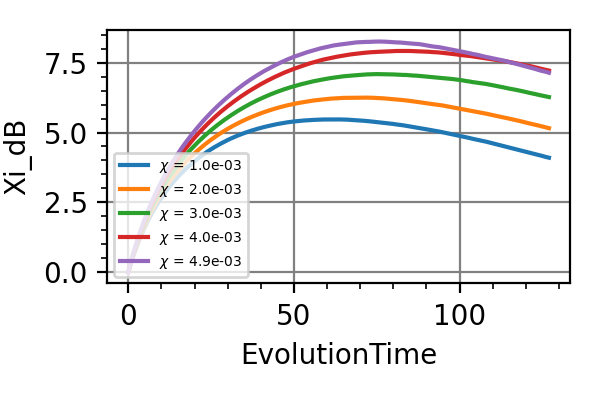
Fig. 52 Squeezing parameter
The point of the optimal strategies is to create squeezing on the x-axis (the one measured by the homodyne detection) and position the state on the p axis as far as possible from the origin, so that the rotation sensitivity is maximized.
In the following plots we report the mean value of the displacement in the phase space for the cavity state, always as a function of time.
At the very beginning the states spread on the x-axis due to the relative high initial thermal noise and the homodyne measurement backreaction, but at the end the controls have managed to give the states a p-components and to reduce the displacement along the x-axis.
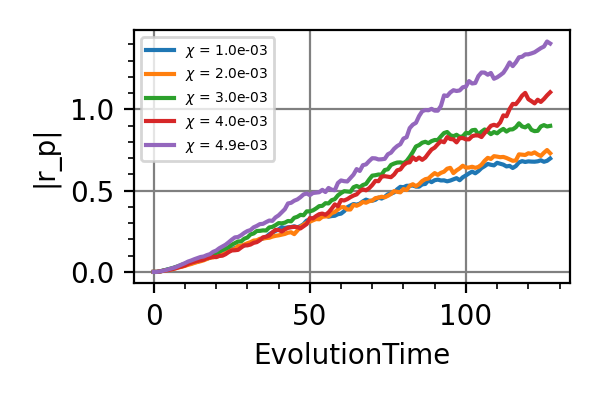
Fig. 53 Mean of
.
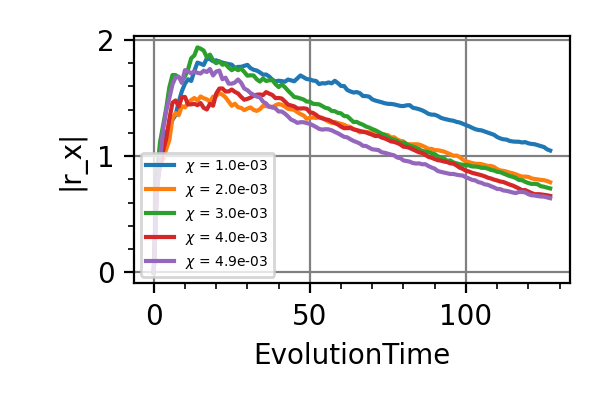
Fig. 54 Mean of
.
Notes
If instead of fixing
we had a interval of possible values for the parameter, i.e. by setting the flag interval of the function
optimize_optical_cavity(), the neural network would be useful to modulate the optimal strategy as a function of.
All the training of this module have been done on a GPU NVIDIA Tesla V100-SXM2-32GB, each requiring
hours.
- optimize_optical_cavity(args, chi: float, interval: bool = False)
Training of the optimal controls for the feedback frequency of the driving laser in the cavity in order to minimize the Cramér-Rao (CR) bound. This function evaluates the performances of a trained neural network, of a static (open-loop) strategy, and of the random controls.
While the squeezing parameters
is variable and passed to the call of the function through the parameter chi, all the other attributes of
CavityParametersare fixed to.
With approximately 1% of the cavity field measured by the homodyne detection at every step we are in the regime of continuous measurements.
Parameters
- args:
Arguments passed to the Python script.
- chi: float
Squeezing parameter of the non-linear crystal in the cavity.
- interval: bool = False
If this flag is True, the minimization of the CR bound is done in the range of detuning frequency
.
- parse_args()
Arguments
- scratch_dir: str
Directory in which the intermediate models should be saved alongside the loss history.
- trained_models_dir: str = “./optical_cavity/trained_models”
Directory in which the finalized trained model should be saved.
- data_dir: str = “./optical_cavity/data”
Directory containing the csv files produced by the
performance_evaluation()and thestore_input_control()functions.- prec: str = “float64”
Floating point precision of the whole simulation.
- n: int = 64
Number of neurons per layer in the neural network.
- batchsize: int = 16
Batchsize of the simulation.
- evolution_time: int = 128
Total evolution time of the cavity.
- learning_rate: float = 1e-2
Initial learning rate for the neural network.
- iterations: int = 1024
Number of training steps.
CFSK Receiver
- class CFSKReceiver(batchsize: int, alphabet_length: int, total_time_pulse: float, average_photon_number: float, delta_t: float, transmittance: float, delta_omega: float, delta_phase: float, time_extention_coefficient: int = 10, control_nullifier_tolerance: float = 0.0001, prec: str = 'float64')
Bases:
StatefulPhysicalModelModel for the M-ary coherent frequency shift keying (CFSK) detector. The system is stateful as the probability of observing a photon in a certain time-bin depends on the time of the last observation.
Constructor of the
CFSKReceiverclass.Parameters
- batchsizeint
Number of receivers simulated at the same time in the batch.
- alphabet_lengthint
Number of messages to be discriminated.
- total_time_pulsefloat
Duration of the pulse.
- average_photon_numberfloat
Average number of photons of the signal.
- delta_tfloat
Approximate time resolution of the detector. Because of how the computation of the probability is implemented, the actual time resolution will be slightly lower than this value, i.e. slightly better.
- transmittancefloat
Transmittance of the unbalanced beam splitter.
- delta_omegafloat
Frequency shift for each hypothesis.
- delta_phasefloat
Phase shift for each hypothesis.
- time_extention_coefficientint, optional
The probability density for observing a photon at a certain time is truncated to zero after a time interval
time_cut = total_time_pulse * time_extention_coefficient, starting from the time of detection of the last photon. This density is normalized to one in[time_last_photon, time_cut], so that a photon is always observed within the timetime_cut, even if the total number of photons in the signal is vanishingly small.This behavior is unphysical, but it is introduced to sample effectively from the said distribution. In the model, this behavior is corrected “by hand”, so that the probability of observing a photon within the time
total_time_pulseis exactly zero for a vanishing photon number.- control_nullifier_tolerancefloat, optional
If the effective controls of the modulated coherent state are less than this threshold, the probability of observing a photon for the rest of the pulse is set to zero exactly.
- precstr, optional
Floating-point precision of the model.
- count_resources(resources: Tensor, outcomes: Tensor, controls: Tensor, true_values: Tensor, state: Tensor, meas_step: Tensor) Tensor
The resource is the elapsed time since the beginning of the pulse.
Through the variable state, we determine whether a photon was measured outside the time duration of the pulse. In such cases, the resource is set to its maximum value total_time_pulse, and this constitutes the final measurement. The Bayesian posterior is updated with the information that no photon was observed within the duration of the pulse.
For the remaining simulations that have not yet reached the final step, the consumed amount of resource is zero. Only two resource values are possible: zero, which is not processed by performance_evaluation, and the maximum possible resource value, total_time_pulse, to which the final error probability is associated.
- initialize_state(parameters: Tensor, num_systems: int) Tensor
State initialization for the receiver. It contains just a single float, which is the time of last detection of a photon. It is initialized to zero.
Notes
The state of the receiver is an observed quantity, in contrast to quantum mechanical states, which are not observed.
- model(outcomes: Tensor, controls: Tensor, parameters: Tensor, state: Tensor, meas_step: Tensor, num_systems: int = 1)
Probability of observing the photon in the time bin indexed by outcome in the CFSK experiment.
Parameters
- outcomes: Tensor
Index of the time bin in which the last photon has been observed. Shape (bs, num_systems, 1) and type prec.
- controls: Tensor
Frequency and phase control for the current photon detection. Shape (bs, num_systems, 1) and type prec.
- parameters: Tensor
Messagges to be decoded. Shape (bs, num_systems, 1) and type prec.
- state: Tensor
Time of the last photon detection. Shape (bs, num_systems, 1) and type prec.
- meas_step: Tensor
Number of collected photons up to the point of calling the function minus one. Shape (bs, num_systems, 1) and type prec.
- num_systems: int = 1
Number of estimations simulated per batch.
Returns
- prob: Tensor
Probabilities associated to the observed time of detection of the photons. Tensor of shape (bs, num_systems) and type prec.
- state: Tensor
Detection time of the last photon. Tensor of shape (bs, num_systems, 1) and type prec.
- perform_measurement(controls: Tensor, parameters: Tensor, true_states: Tensor, meas_step: Tensor, rangen: Generator)
Stochastically extracts the time of detection of the next photon.
Parameters
- controls: Tensor
Controls for the frequency and phase of the coherent state to be added to the signal. Shape (bs, 1, 2) and type prec.
- parameters: Tensor
Message to be deciphered. Shape (bs, 1, 1) and type prec.
- true_states: Tensor
Time of detection of the last photon. Shape (bs, 1, 1) and type prec.
- meas_step: Tensor
Number of collected photons up to the point of calling the function minus one. Shape (bs, 1, 1) and type prec.
- rangen: Generator
Random number generator.
Returns
- outcomes: Tensor
Tensor of integers (casted to prec type) that contains the position of the extracted value in range_times. This is an internal index used to represent the time bin in which the detection occourred. Shape (bs, 1, 1) and type prec.
- log_prob: Tensor
Logarithm of the probability of the observed time for the photon detection. Shape (bs, 1) and type prec.
- true_state: Tensor
Detection time of the current photon. Shape (bs, 1, 1) and type prec.
- class CFSKSimulation(particle_filter: ParticleFilter, phys_model: CFSKReceiver, control_strategy: Callable, simpars: SimulationParameters)
Bases:
StatefulSimulationSimulation class for the CFSK receiver. It works with a
ParticleFilterand aCFSKReceiverobjects.Constructor of the
CFSKSimulationclass.Parameters
- particle_filter:
ParticleFilter Particle filter responsible for the update of the Bayesian posterior on the message.
- phys_model:
CFSKReceiver Model of the CFSK receiver.
- control_strategy: Callable
Control for the frequency and phase of the local oscillator.
- simpars:
SimulationParameters Parameter simpars passed to the class constructor.
- generate_input(weights: Tensor, particles: Tensor, state_ensemble: Tensor, meas_step: Tensor, used_resources: Tensor, rangen: Generator)
The input is the full posterior probability distribution on the set of discrete hypothesis.
- loss_function(weights: Tensor, particles: Tensor, true_state: Tensor, state_ensemble: Tensor, true_values: Tensor, used_resources: Tensor, meas_step: Tensor)
The loss function is the categorical classification error for the recovery of the message.
- particle_filter:
- cfsk_simulation(args, alphabet_length: int = 16, total_time_pulse: float = 1.0, average_photon_number: float = 4.0, delta_t: float = 0.01, learning_rate: float = 0.01)
Simulation of the receiver.

The picture represents the mixing on a BS of the signal and the controlled local oscillator.
For these simulations we have chosen
and
, which are indicated as optimal in 10.
- 10
I.A. Burenkov, M.V. Jabir, A. Battou, and S.V. Polyakov, PRX Quantum 1, 010308 (2020).
Parameters
- args:
Arguments passed to the Python script.
- alphabet_length: int = 16
Length of the alphabet transporting the message.
- total_time_pulse: float = 1.0
Time length of the pulse.
- average_photon_number: float = 4.0
Average photon number in the signal that transmits the message.
- delta_t: float = 0.001
(Pseudo)-time resolution of the photon detector.
- learning_rate: float = 1e-2
Initial learning rate for the neural network. It decays with
InverseSqrtDecay, from that point on.
- main()
We simulate the execution of the CFSK receiver for various alphabet lengths, signal pulse durations, and average photon numbers in the signal. Three strategies are studied, all based on Bayesian estimation.
1) The first strategy involves using the maximum posterior hypothesis as the local oscillator to subtract from the signal, as done in the original works.
2) The second strategy employs a neural network that processes the probabilities of all possible hypotheses and outputs the frequency and phase of the controls.
3) The third strategy combines the two approaches: the control produced by the neural network is superimposed onto the “maximum a posteriori” strategy, and the neural network is trained to identify deviations from this behavior.
Using the implemented controls—i.e., the phase and frequency of the local oscillator, both based on Bayesian probability updates—we observe no improvement compared to the original “maximum a posteriori” strategy. This might change if:
a) we implement the ability to control the amplitude of the local oscillator, or b) we use a decision tree for the control.
- parse_args()
Arguments
- scratch_dir: str
Directory in which the intermediate models should be saved alongside the loss history.
- trained_models_dir: str = “./cfsk_receiver/trained_models”
Directory in which the finalized trained model should be saved.
- data_dir: str = “./cfsk_receiver/data”
Directory containing the csv files produced by the
performance_evaluation()and thestore_input_control()functions.- prec: str = “float64”
Floating point precision of the whole simulation.
- batchsize: int = 256
Batchsize of the simulation.
- n: int = 64
Number of neurons per layer in the neural network.
- iterations: int = 32768
Number of training steps.